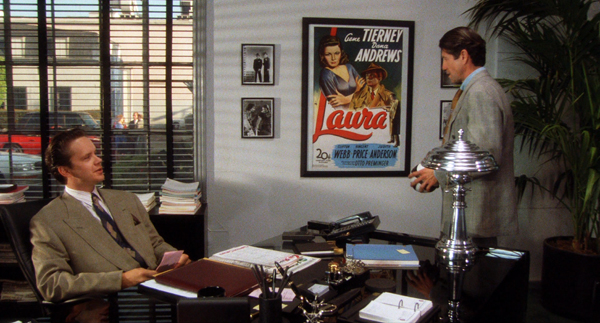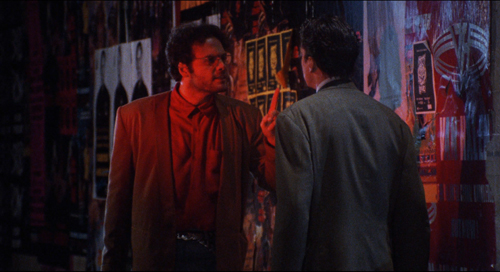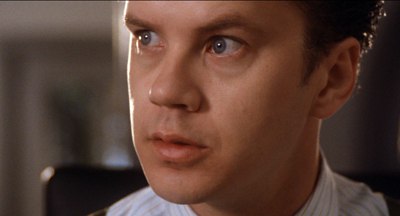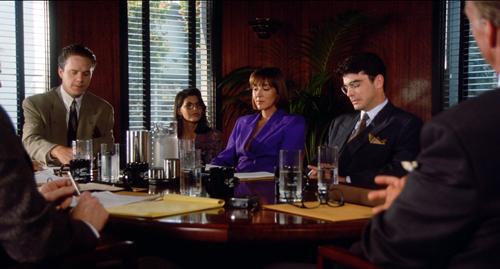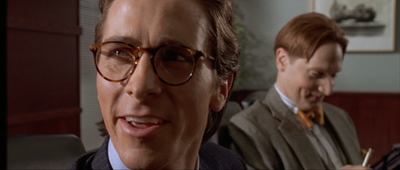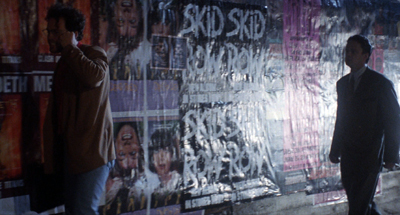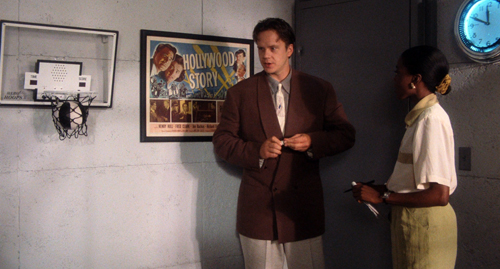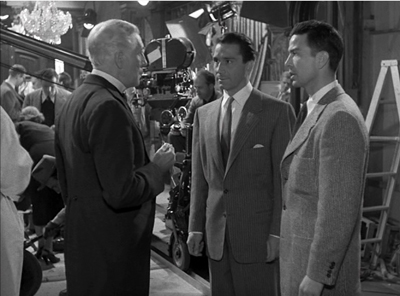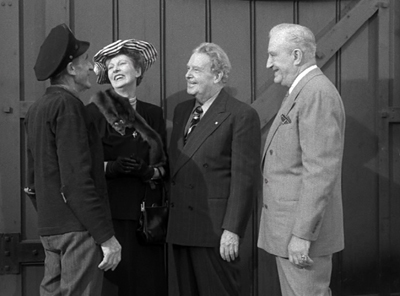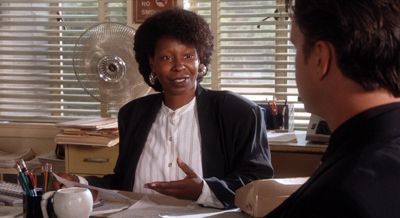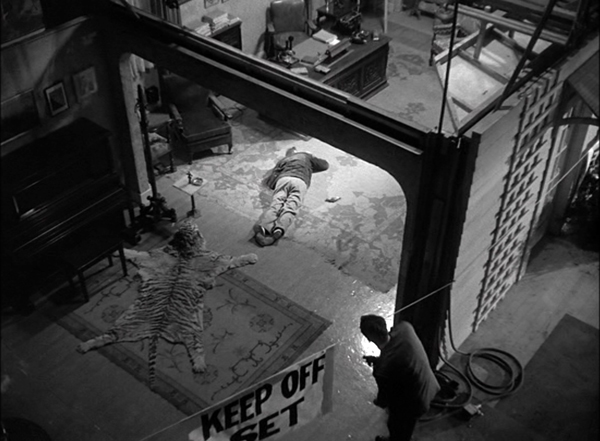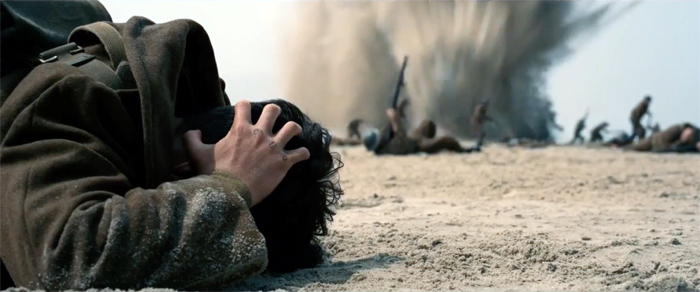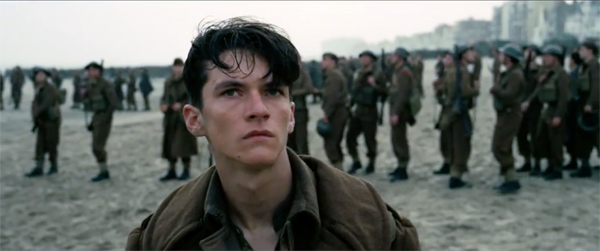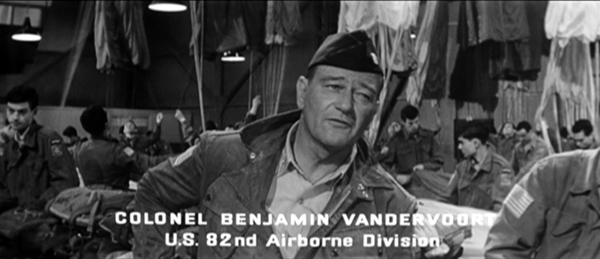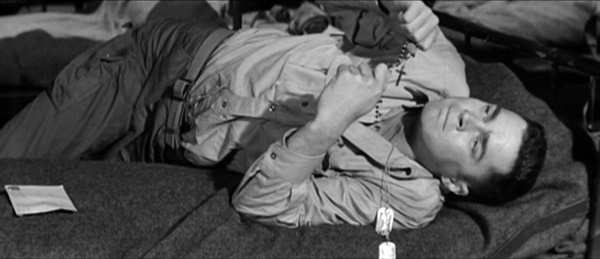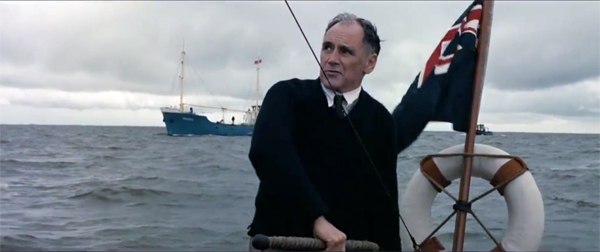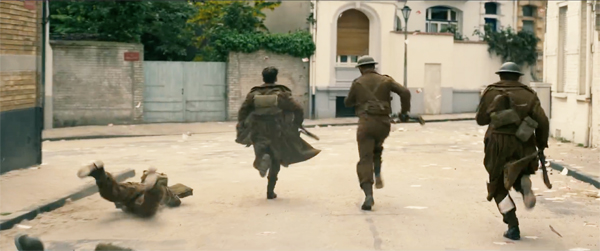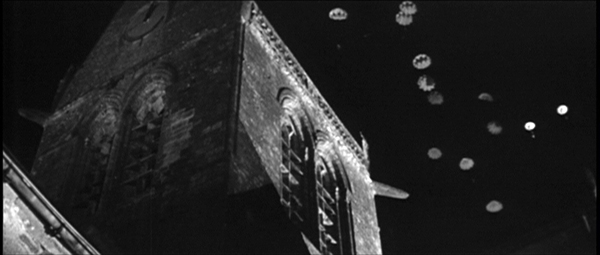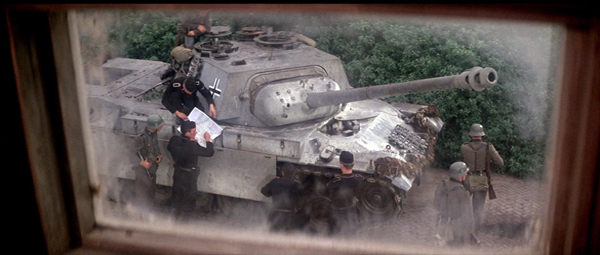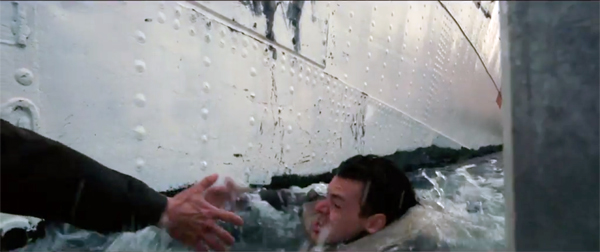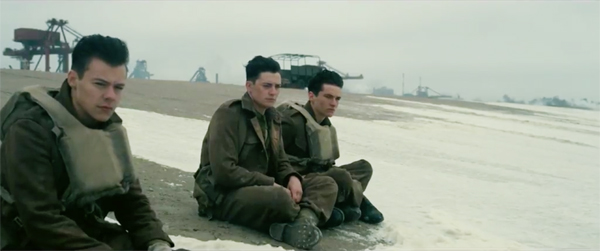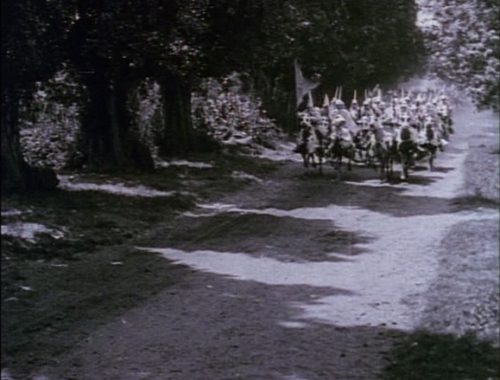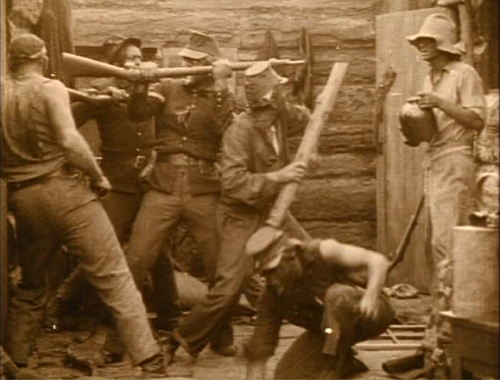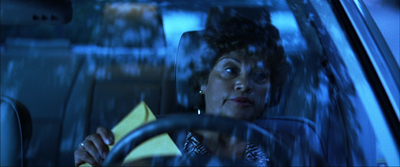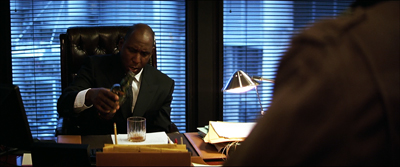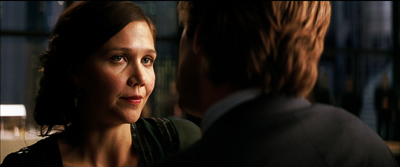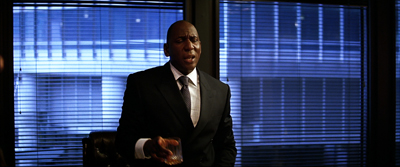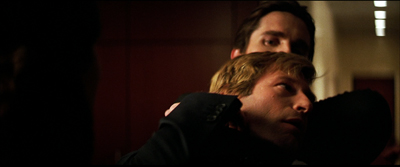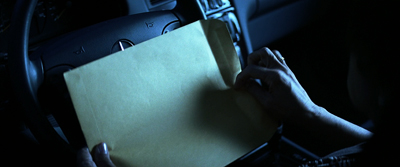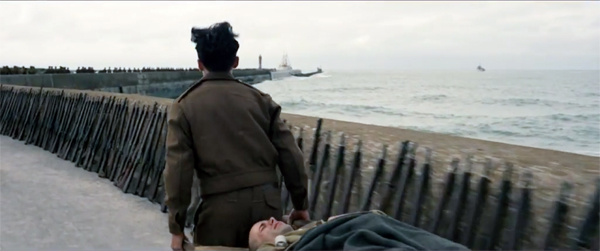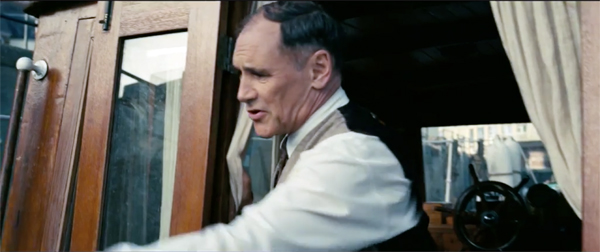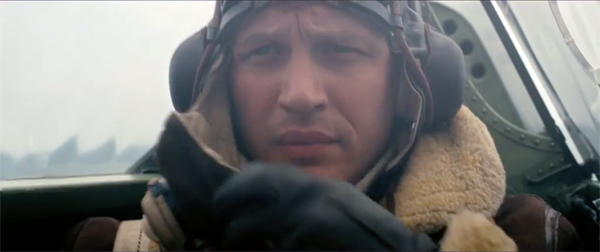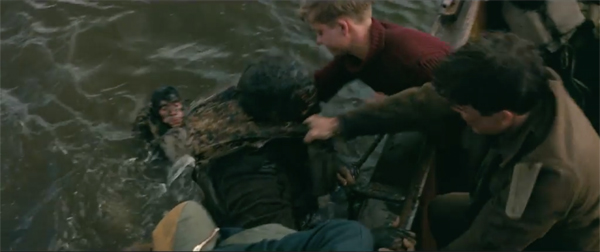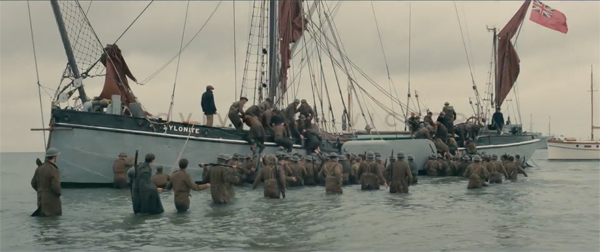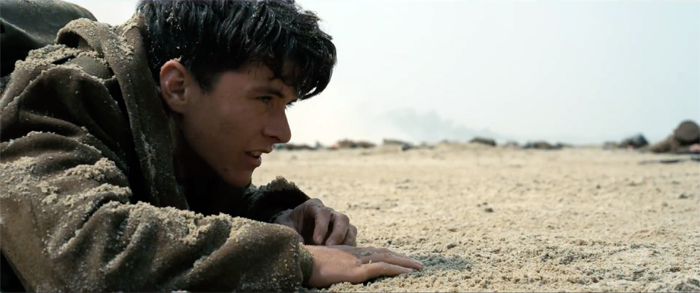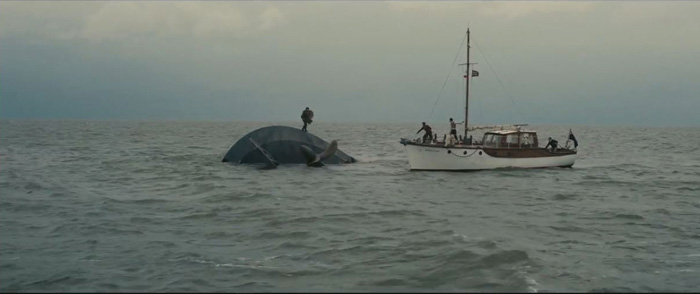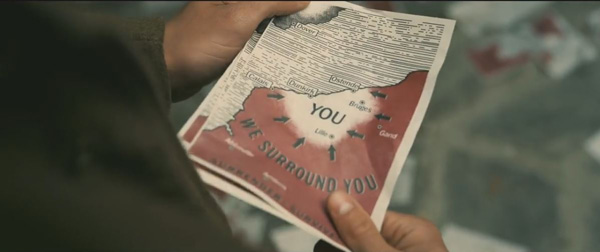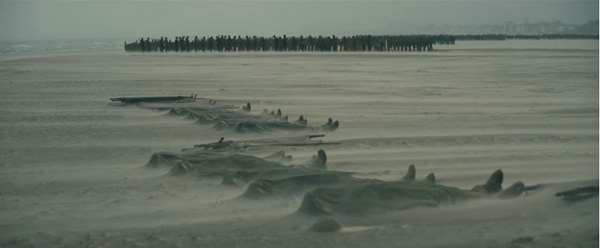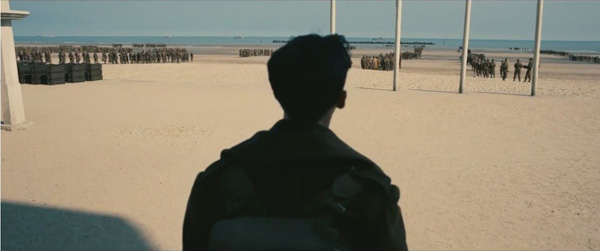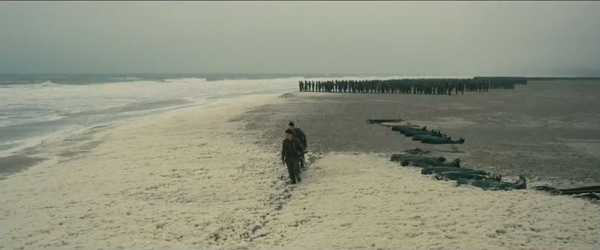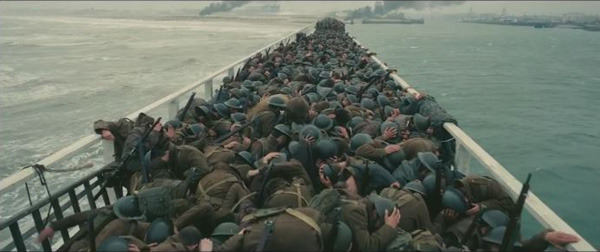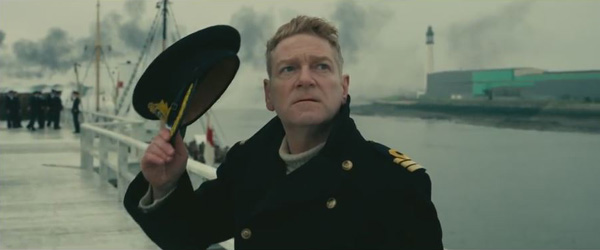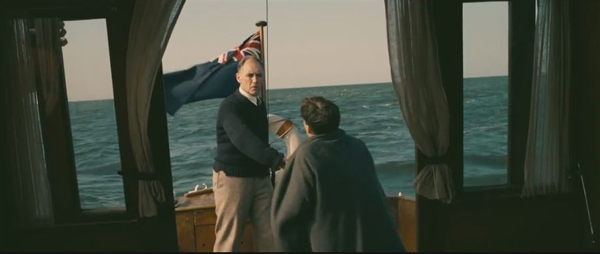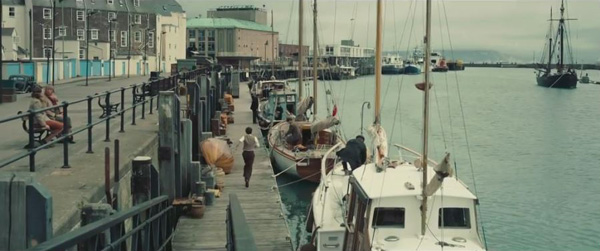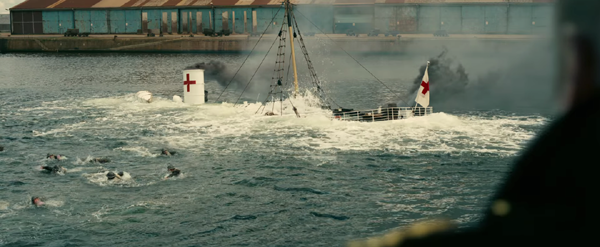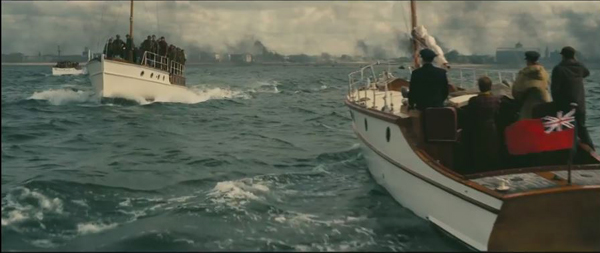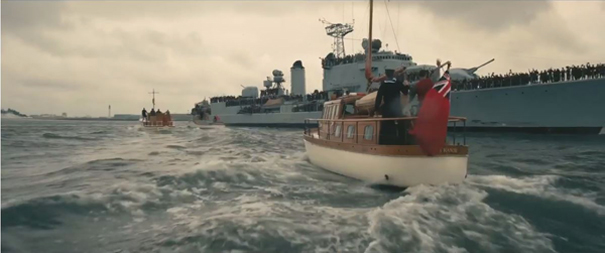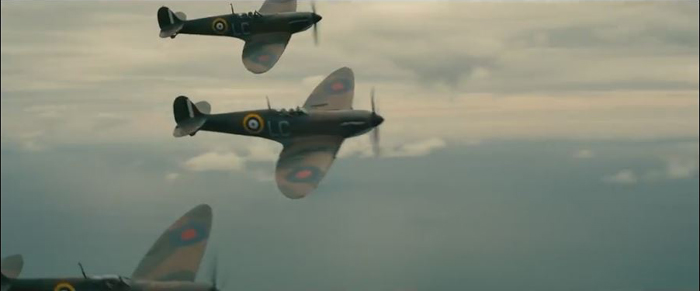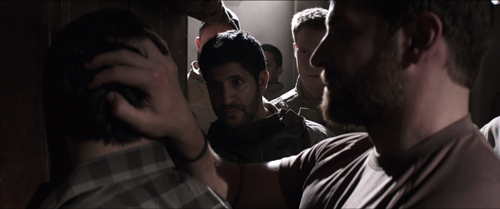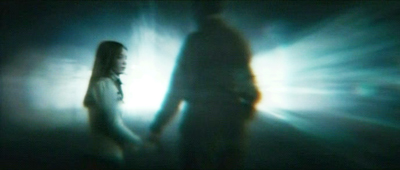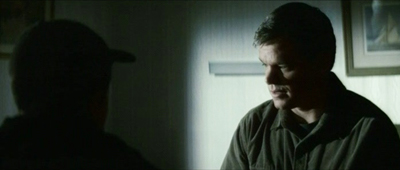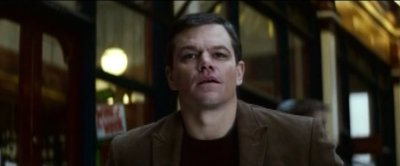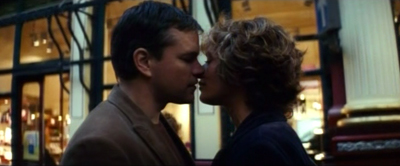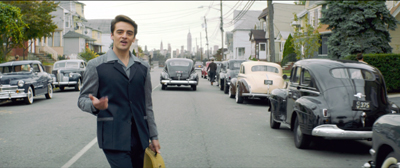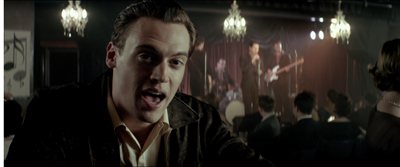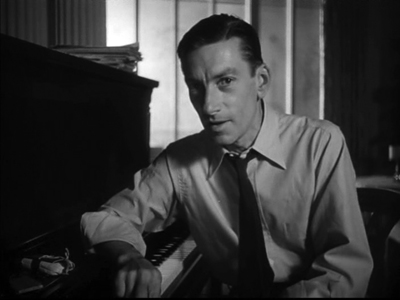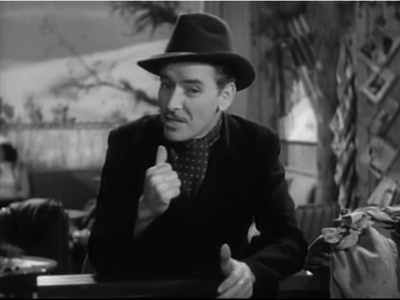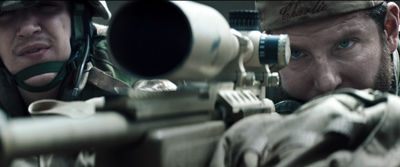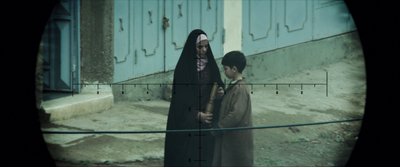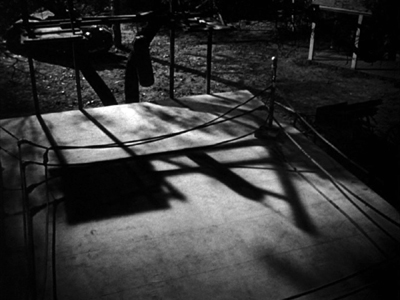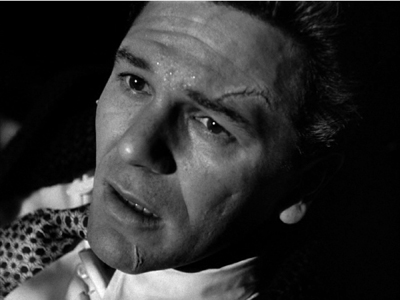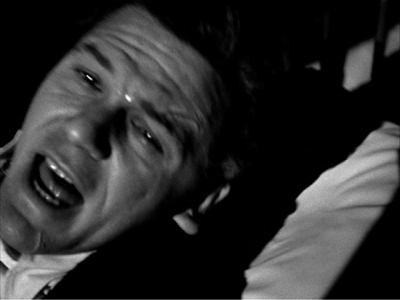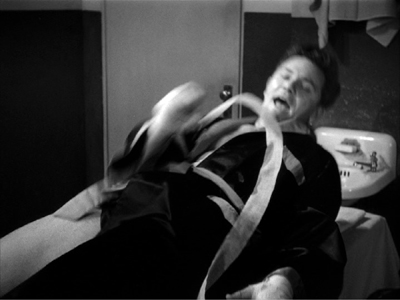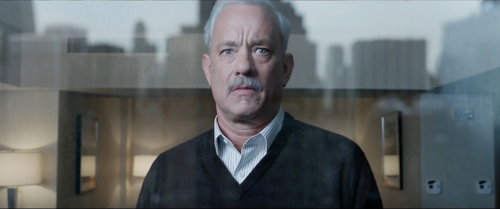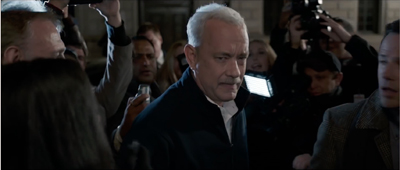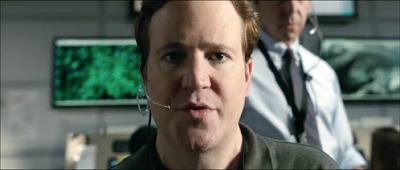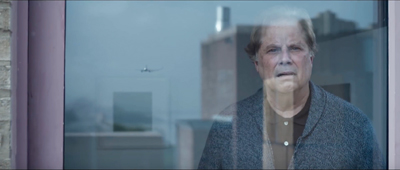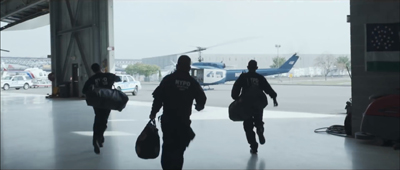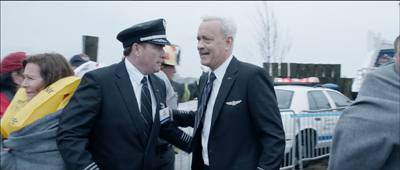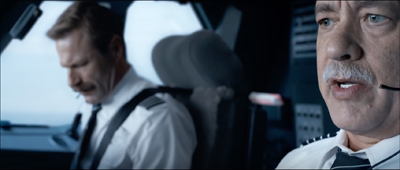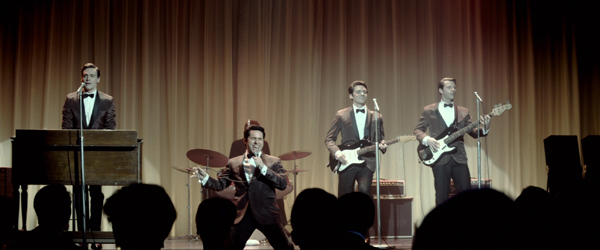Archive for the 'Narrative: Suspense' Category
Who got played? A guest post by Jeff Smith on THE PLAYER
The Player (1992).
Jeff Smith, our collaborator on Film Art: An Introduction just recorded an installment of our Observations on Film Art series for the Criterion Channel on FilmStruck. Here’s a supplement to that. –DB
In my installment, focusing on genre play in The Player, I discuss Robert Altman’s film in relation to two important traditions in Hollywood cinema: crime thrillers and films about filmmaking. As anyone who knows Altman’s other films would expect, The Player toys with the conventions of both genres in a number of different ways.
As I note in the video, The Player was received as something of a comeback film for Altman. It augured a resurgence in the director’s career that ultimately produced such late masterpieces as Short Cuts and Gosford Park.
Today, I sketch out some additional ideas about The Player’s use of genre conventions. I hope to shed light on some other connections to the crime thriller that I didn’t discuss in the video. I also hope to show just how unusual the film is in this context. Spoilers ahead, not only for The Player but for the novel and film of The Ax.
Will the real Griffin Mill please stand up?
In Reinventing Hollywood, David notes that there are usually four sorts of characters involved in a crime thriller plot: victims, lawbreakers, forces of justice, and more or less innocent bystanders. Filmmakers customarily organize the film’s narration around one or more of these character roles. Typically, a cascade of further choices flows from this initial decision about whose perspective forms the focal point of the story.
In The Player, much of the narration is restricted to the knowledge of the protagonist, Griffin Mill. The film includes a few scenes where Griffin is not present, like the one where the studio’s management awaits his arrival at a meeting. That, in itself, is not unusual. Many thrillers, like Chinatown or The Ghost Writer, employ similar tactics. What is slightly unusual is the fact Griffin takes on two of the typical character roles in the crime thriller as both victim and lawbreaker.
Griffin is a suit, and as a studio functionary he doesn’t immediately engender audience sympathy. Our first glimpse of Griffin shows him listening to pitch sessions. His questions to the people proposing new film projects are glib and capricious, representing the worst aspects of Hollywood commercialism.
Yet The Player does marshall some sympathy for Griffin as the victim of a stalker. Every time Griffin finds a postcard in his mail or on his car, it reminds us that he might be in mortal danger. After the stalker plants a venomous rattlesnake in Griffin’s passenger seat, we can’t believe the threats are empty.
Any sympathy that Griffin garners as a result of this psychological warfare is mollified, though, when the victim becomes victimizer. As Griffin later explains to June, his job is to tell people “no” more than a thousand times each year. Griffin believes that one of these rejections is the reason for the threatening postcards he receives. But he tragically miscalculates in targeting aspiring screenwriter David Kahane as the likely suspect.
Griffin contrives a meeting with Kahane at a Pasadena movie theater, and having bumped into him, tries to make amends. Yet Kahane recognizes that he is being pimped. This leads to a shouting match in a parking lot with Kahane threatening to ruin Griffin’s reputation. And when Kahane accidentally knocks Griffin over with his car door, Griffin reacts with rage, grabbing the screenwriter’s head and banging it repeatedly against the lot’s concrete surface. Although it seems clear that Griffin was acting on impulse, he’s nonetheless crossed a line that separates victims from perpetrators.
More importantly, Griffin’s violent action complicates the viewer’s allegiance to him. Altman establishes a dramatic context in which the motivations for Griffin’s crime seem completely understandable. Yet whatever sympathies viewers might have for Griffin are muddled by his creepy romantic interest in Kahane’s girlfriend; his cruel treatment of Bonnie, his current partner; and the general smarminess he exudes as a successful but shallow executive. Crime thrillers often ask audiences to sympathize with heels. There’s nothing that Griffin does that is inherently evil, but there’s nothing to really like. It’s less about his crime and more about his slime.
Griffin’s passage from victim to lawbreaker also alters the typical thriller plot. At the start of the film, Griffin himself functions as the investigative agent, trying desperately to figure out who is threatening him. Once Griffin becomes a suspect himself, though, that line of action halts, and the Pasadena police’s investigation of Kahane’s death springs up in its place.
This shift in the direction of the plot doesn’t really change the film’s pattern of narration. We remain as ignorant of the police’s activities as Griffin is. What does change are the stakes of the narrative. Instead of eliciting curiosity and suspense about Griffin’s stalker, we now wonder whether he’ll ever be brought to justice for Kahane’s death. Despite its strong connections and frequent allusions to crime fiction, The Player is not so much a whodunit as it is a will-he-get-away-with-it.
They smile in your face, all the time they want to take your place….
Besides blurring the boundaries between Griffin’s role as both victim and lawbreaker, The Player falls into a specific subgenre of crime fiction: the corporate thriller. Since, the corporate thriller is mostly defined by its setting, it blends pretty easily with the typical thriller plots and characters.
Like the spy thriller, the corporate thriller can focus on protagonists engaged in industrial espionage, as we see in Duplicity, Demon Lover, or Paycheck. Christopher Nolan’s Inception blends the plot mechanics of these corporate espionage thrillers with science fiction tropes to provide a narrative frame, but then embeds elements of the heist film within it.
Like the political thriller, the corporate thriller might also focus on the backroom deals and machinations that enable the protagonist to move up the company ladder. A film like Disclosure is a paradigm case. But even romantic comedies or prestige dramas can borrow elements from it. (Think Working Girl and Glengarry Glen Ross.)
More commonly, though, corporate thrillers feature elements drawn from the crime thriller. The roots of this approach to the genre stretch back a long way and can be found in both literary and cinematic antecedents. Some plots, for example, follow investigations that expose corporate malfeasance. Others focus on murders committed within a corporate environment, as in Dorothy Sayers’s novel Murder Must Advertise and Kenneth Fearing’s novel (and film) The Big Clock and in more modern instances like Michael Crichton’s Rising Sun and John Grisham’s The Firm. Other corporate crime thrillers, like Bret Easton Ellis’s American Psycho (below) and Cindy Sherman’s Office Killer, involve serial murders in white-collar environments.
The corporate crime thriller enables writers and filmmakers to explore thematic parallels between the acts of brutality and violence committed by individuals and the cutthroat tactics employed by business institutions. The plots of many gangster films center on rival mobs battling for competitive dominance in black market trades. Such conflicts often seem like a logical extension of the laissez-faire principles that undergird capitalism. Corporate crime thrillers tread similar thematic territory. They sometimes suggest that the personality traits that make for good business executives and titans of industry are the same ones that produce sociopaths and serial killers.
The Player presents the familiar corporate-thriller rivalry, as Griffin works behind the scenes to outmaneuver Larry Levy. For example, Griffin momentarily ponders using Larry’s admission that he attends Alcoholics Anonymous meetings as a way of embarrassing him within the company. Larry quickly undercuts this strategy, though, when he states that he just goes to the meetings because they are a great place to network.
Even more telling is Griffin’s efforts to saddle Larry with a loser project, Habeas Corpus. Midway through The Player, Griffin makes a deal with Andy Civella and Tom Oakley at a Los Angeles restaurant. The next day, he convinces his boss to greenlight the project with Larry as producer, knowing that Tom will likely prove difficult to work with and that his plan to use unknown actors has disaster written all over it. Larry, though, has the last laugh when we get a sneak peek of Habeas Corpus at film’s end. Not only does it have big stars in Julia Roberts and Bruce Willis. It also has the kind of happy ending that the pretentious Tom claimed was too Hollywood when he pitched the project. It turns out Tom cares more about the results of preview screenings than he does the purity of his artistic vision.
Not surprisingly, Altman doesn’t give us a wholly straightforward version of the corporate thriller. In a reflexive and ironic touch, Griffin’s successful ascent to studio boss seems to be secured by the same mysterious stalker who’d been taunting him at the start of the film. In a phone call, the stalker pitches Griffin the plot of the film we’ve just been watching, using his knowledge of Griffin’s crime to leverage his project into development. Here we see Altman slightly reframing the genre’s thesis about the relationship between crime and business. Griffin’s pact with his blackmailing stalker is simply a mildly illicit version of the sorts of quid pro quo arrangements upon which thousands of business deals are made.
If Griffin’s efforts to forestall a rival evoke the political thriller, then his killing of screenwriter David Kahane connects The Player to the corporate crime thriller. Once again, Altman deviates from some of the conventions. The crime doesn’t take place inside a corporate setting, as in Rising Sun and Murder Must Advertise. Griffin kills Kahane in the very public space of a Pasadena parking lot, with film noir overtones.
Similarly, Griffin’s victim is not a colleague, co-worker, subordinate, or client. Rather, Kahane is someone with whom Griffin has had minimal contact, a name plucked almost randomly from a directory of screenwriters in order to jog Griffin’s memory. Consequently, Griffin’s motives for confronting Kahane seem quite different from the culprits in other corporate crime thrillers. More often than not, the murderers in these other stories fear job loss or try to silence others in an effort to cover up some smaller crime or bungled action. Griffin’s actions with Kahane spring from fear about threats to his physical well-being, not from threats to his continued employment. (The latter is Larry’s role.)
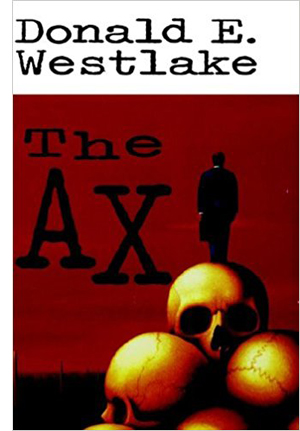 Some of The Player’s deviations from more conventional corporate crime thrillers come into relief if we compare it to Donald Westlake’s novel The Ax, a purer example of the genre. The Ax tells the story of Burke Devore, a production line manager recently downsized out of his job at a paper company. Still unemployed after eighteen months, Burke creates a phony job advertisement, and then begins to kill off the seven applicants he believes have the same qualifications he does. His plan is to eliminate all of the other unemployed middle managers in the paper business so that his resumé will land at the top of the pile when a new factory opens in his area.
Some of The Player’s deviations from more conventional corporate crime thrillers come into relief if we compare it to Donald Westlake’s novel The Ax, a purer example of the genre. The Ax tells the story of Burke Devore, a production line manager recently downsized out of his job at a paper company. Still unemployed after eighteen months, Burke creates a phony job advertisement, and then begins to kill off the seven applicants he believes have the same qualifications he does. His plan is to eliminate all of the other unemployed middle managers in the paper business so that his resumé will land at the top of the pile when a new factory opens in his area.
Like Altman, Westlake has some fun with his central conceit. Just as The Player includes faux film clips and rushes as a means of satirizing Hollywood production practices, The Ax incorporates fictional resumes that tweak jobseekers’ business-speak. What makes Westlake’s social criticism in The Ax so resonant, though, is the utter banality of Burke’s ambitions. He doesn’t aspire to the garish lifestyle we see displayed by Tony Montana or Jordan Belfort in Scarface and The Wolf of Wall Street respectively. Instead Burke just wants to return to his modest middle-class lifestyle and to the dignity that a decent job afforded him. Serial murder just seems like the simplest way to achieve that.
As this comparison suggests, one of the things that makes The Player somewhat unusual as a corporate crime thriller is its play with character motivation and point of view. Facing threats and intimidation, Griffin looks more like the target of a crime than a perpetrator. In corporate thrillers, the lawbreaker is more likely to be somewhere in the middle of the corporate ladder, like Burke, than at the top of it. Moreover, although his actions are motivated by a strange combination of both vanity and insecurity, Griffin more or less stumbles into the crime he commits rather than coolly plotting it the way Burke does.
Despite these differences, The Player and The Ax share an important feature that markedly deviates from the crime thriller as a whole. Both Griffin and Burke get away with it. The plots of most crime thrillers resolve in ways that balance the scales of justice. The bad guys are usually either arrested or killed after climactic confrontations with law enforcement. But this doesn’t always happen. Burke, Patrick Bateman in American Psycho, and Dorine in Office Killer escape punishment. Even though Jordan Belfort is arrested in The Wolf of Wall Street, he gets a slap on the wrist for his crimes.
Perhaps this aspect of the corporate crime thriller reflects the cynicism and amorality that pervades the genre. After all, if your belief is that most corporations get away with murder in a figurative sense, then it’s not hard to accept this idea when it occurs in fictional contexts in a literal sense.
Still, in the case of The Player, the Pasadena police’s failure to prove their case against Griffin Mill may reflect a meshing of both authorial and generic tendencies. When Griffin embraces June in the stylized happy ending of The Player, it quite deliberately parallels the tacked on happy ending of Habeas Corpus we’ve seen just moments earlier. The dialogue Griffin exchanges with June amplifies the similarity between these scenes. When June asks, “What took you so long?”, Griffin responds, “Traffic was a bitch.” These are the exact same lines exchanged by Julia Roberts and Bruce Willis in Habeas Corpus. By allowing Griffin to get away with it, The Player’s “up” ending sharpens Altman’s critique of Hollywood convention, and allows him to subvert the kinds of mainstream genre filmmaking he’s long detested.
Both allusive and elusive: Comparing The Player to Hollywood Story
One of the other topics I discuss in my video essay on The Player is the way the film pays homage to various aspects of Hollywood tradition. Much of this is bound up with its satire of commercial filmmaking. But it also strengthens the film’s relation to the crime thriller. Throughout The Player, Altman makes reference to Hollywood’s past in multiple ways. Celebrity cameos, film posters, and production stills populate the mise-en-scene. The characters also frequently mention older film titles in dialogue.
Perhaps the most interesting allusion in The Player involves a poster of Hollywood Story that hangs in Griffin’s office. The latter is a 1951 film noir directed by William Castle, who later became famous for his use of outrageous gimmicks in the production and promotion of horror films. For The Tingler, Castle supervised the installation of devices that would vibrate theater seats, anticipating today’s 4DX Theater Experience in places like Los Angeles, New York, Seattle, and Orlando.
Hollywood Story dramatizes the efforts of film producer Larry O’Brien to develop a project around the unsolved murder of silent film director Franklin Ferrara. O’Brien hires one of Ferrara’s old scenarists to write the script. He also develops a close relationship with Sally Rousseau, the daughter of one of Ferrara’s biggest stars. Once the project is announced, O’Brien finds himself the target of an assassin’s bullet. He surmises that his assailant is trying to prevent the case from being reopened. And as Sally reminds O’Brien, he doesn’t have an ending to his movie is he can’t determine the killer’s identity. O’Brien, thus, sets out to solve the crime, bringing closure to one of the biggest scandals in Hollywood’s history. Hollywood Story offers an even better synthesis of The Player’s mixture of industry exposé and crime film story beats. O’Brien’s lone wolf investigation is treated as being a necessary stage of project development.
If the Franklin Ferrara story sounds vaguely familiar to you, well….it should. Hollywood Story offers a fictionalized account of the unsolved murder of William Desmond Taylor, who was shot to death in his bungalow in the wee hours of a February night in 1922. (David blogged about the crime here.) The subsequent investigation of Taylor’s death ensnared some of the industry’s biggest stars of the period. Mabel Normand’s reputation was tainted by her association with Taylor and by reports of drug use. She took a brief hiatus from filmmaking because of the scandal, but never completely recovered from it. Normand later died of tuberculosis in 1930 at the tender age of 37.
As a fictionalized account of a notorious unsolved crime, Hollywood Story anticipates more modern thrillers that provide speculative solutions to real-life murders. Zodiac and The Black Dahlia are prime examples, as are any number of Jack the Ripper films. Hollywood Story’s approach was not unprecedented. James M. Cain based Double Indemnity on the Ruth Snyder case that was fodder for New York tabloids in the late 1920s. That said, Taylor’s death lingered for decades in popular memory in a way that the Snyder case did not.
What are we to make of The Player’s citation of Hollywood Story? On the one hand, viewers might well notice the almost immediate parallel of our “film execs in jeopardy” storylines. Just as Griffin is stalked by an unknown assailant, so, too, is Larry the target of a shadowy aggressor. Moreover, Hollywood Story, along with Sunset Boulevard, might well be an inspiration of one of The Player’s most interesting features: its intermingling of real life stars with fictional characters. Hollywood Story includes cameos by Joel McCrea and several noted performers of the silent era, such as William Farnum, Francis X. Bushman, and Betty Blythe (below). The Player pushes this aspect of Hollywood Story to extremes, containing plentiful cameos by Cher, Jack Lemmon, Burt Reynolds, Lily Tomlin, Susan Sarandon, and other A-listers.
In several other respects, though, The Player seems like an inversion of Hollywood Story with Griffin emerging as a more venal counterpart to the latter’s crusading producer, Larry. In Hollywood Story, Larry’s investigation actually produces results. This strongly contrasts with Griffin’s guesswork, which, as the result of a tragic mistake, leads to David Kahane’s death in a Pasadena parking lot. In Hollywood Story, Larry’s blossoming romance with Sally furnishes the standard double plotline commonly found in classical cinema. In The Player, though, Griffin’s interest in June seems genuinely sleazy. It also exacerbates the Pasadena police’s doubts about Griffin’s alibi, making him their prime suspect. Finally, the revelation of screenwriter Vincent St. Clair as Franklin Ferrara’s killer provides closure both to Larry’s script and to Hollywood Story itself. In contrast, none of the crimes presented in The Player are really solved. Griffin is blackmailed into greenlighting a project during the film’s epilogue, but the audience never learns the identity of the mysterious stalker. Similarly, although the Pasadena police believe that Griffin is guilty of murder, the botched lineup ensures that he will go free and that David Kahane’s death will remain an unsolved crime. In an odd way, The Player returns to the narrative roots of Hollywood Story. The fate of Kahane, our aspiring screenwriter, seems destined to mirror that of poor William Desmond Taylor, our successful silent film director.
A thriller with no thrills
I’ve sketched out a number of different ways in which The Player relates to the basic conventions of the crime thriller, but all of this is ultimately, in the parlance of the genre, a red herring. This is because The Player is that rare bird: a crime film that engenders relatively little curiosity about its solution and even less suspense about the fate of its protagonist.
This is largely because Robert Altman mostly uses crime film conventions as scaffolding for the things that really interest him: quirky characters, digressive dialogue, and a loose, improvisatory feel to the film’s performances. At its heart, The Player is a comedy that draws upon crime film conventions in much the way Altman’s adaptation of Raymond Chandler’s The Long Goodbye does.
Compare, for example, each film’s tweaking of the genre’s standard interrogation scenes. In The Long Goodbye, Detective Farmer’s tough questioning of Philip Marlowe is punctured by the latter’s goofy responses. At one point, Marlowe uses the ink from his fingerprinting procedure like it was the “eye black” used by an athlete. Later, he smears the ink all over his face and sings “Swanee” in a mocking homage to Al Jolson in blackface. Similarly, in The Player, the Pasadena police’s interrogation of Griffin is disrupted by Detective Avery’s disarming exchange with her partner about tampons, her mangled pronunciation of “Gudmundstottir,” and her dialogue with Paul about Todd Browning’s Freaks.
The Player has many ingredients characteristic of crime films: a dead body, an investigation, a shady suspect, and a campaign of stalking and extortion. Yet, by the time Altman’s film reaches its ironic and deeply reflexive conclusion, viewers might well conclude that they are the ones who just got played.
Thanks as usual to Peter Becker, Kim Hendrickson, Grant Delin, and all their Criterion colleagues. A list of our Observations on Film Art series is here.
For more on Robert Altman’s career, see Patrick McGilligan’s excellent biography, Robert Altman: Jumping Off the Cliff. There are also several books featuring interviews with the iconoclastic director. These include David Sterritt’s Robert Altman: Interviews, Mitchell Zuckoff’s Robert Altman: The Oral Biography, and David Thompson’s Altman on Altman.
Those interested in learning more about crime fiction should consult Martin Rubin’s Thrillers, Charles Derry’s The Suspense Thriller: Films in the Shadow of Alfred Hitchcock, John Scaggs’s Crime Fiction, Richard Bradford’s Crime Fiction: A Very Short Introduction, and Martin Priestman’s The Cambridge Companion to Crime Fiction.
Hollywood Story (1951).
DUNKIRK Part 2: The art film as event movie
Dunkirk (2017).
DB here:
In some ways Christopher Nolan has become our Stanley Kubrick. Many directors have found ways to turn genre movies into art films; think of Wes Anderson and comedy, or Paul Thomas Anderson and melodrama. But seldom does the result become both a prestige picture and an event film.
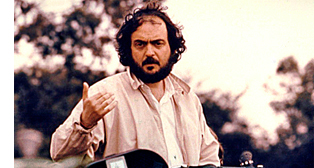 Kubrick managed it. After showing his commercial acumen with Spartacus, Lolita, and Dr. Strangelove (costume picture, controversial adaptation, satire) he was able to make 2001, a meditation on life and the cosmos in the trappings of science fiction. From then on, he could frame any project as both working in a familiar genre and offering a challenging narrative or theme. Thanks to shrewd marketing of both each project and his image, he invested his adaptations (A Clockwork Orange, Barry Lyndon, The Shining, Full Metal Jacket, Eyes Wide Shut) with a must-see aura. Whether or not the film was a top grosser, people said, this is a guy a studio wants to be in business with. Warners obliged.
Kubrick managed it. After showing his commercial acumen with Spartacus, Lolita, and Dr. Strangelove (costume picture, controversial adaptation, satire) he was able to make 2001, a meditation on life and the cosmos in the trappings of science fiction. From then on, he could frame any project as both working in a familiar genre and offering a challenging narrative or theme. Thanks to shrewd marketing of both each project and his image, he invested his adaptations (A Clockwork Orange, Barry Lyndon, The Shining, Full Metal Jacket, Eyes Wide Shut) with a must-see aura. Whether or not the film was a top grosser, people said, this is a guy a studio wants to be in business with. Warners obliged.
Like Kubrick, Nolan moved from the independent realm to an assignment (Insomnia) before being entrusted with a big picture, the first of the Batman reboots. As he developed the Dark Knight trilogy, he made two films in the one-for-them, one-for-me mode (The Prestige, Inception). But Inception became his 2001, a genre hybrid (science-fiction/heist film) that proved that he could turn an eccentric “personal” project into a blockbuster. After The Dark Knight Rises, Interstellar showed that he could make an original genre film that was both prestigious (brainy, based on real science) and an event film. He became another director you want to be in business with. Warners obliged.
 There are other affinities, surely. Both Kubrick and Nolan are often considered cerebral technicians, setting themselves gearhead problems with each project. They’re called cold as well. In Kubrick’s case, his detachment is best understood, as Jim Naremore has convincingly argued, as a commitment to the grotesque. Nolan, on the other hand, takes strong emotional situations as his premise but subordinates them to labyrinthine formal designs. For example, the conventional device of the dead wife justifies intricate plot structures in both Memento and Inception. Sensitive to the charge of coldness, in promoting every film Nolan emphasizes how his formal strategies aim to enhance emotion. But Kristin and I think that they’re of intrinsic interest, as she argues in relation to exposition in Inception.
There are other affinities, surely. Both Kubrick and Nolan are often considered cerebral technicians, setting themselves gearhead problems with each project. They’re called cold as well. In Kubrick’s case, his detachment is best understood, as Jim Naremore has convincingly argued, as a commitment to the grotesque. Nolan, on the other hand, takes strong emotional situations as his premise but subordinates them to labyrinthine formal designs. For example, the conventional device of the dead wife justifies intricate plot structures in both Memento and Inception. Sensitive to the charge of coldness, in promoting every film Nolan emphasizes how his formal strategies aim to enhance emotion. But Kristin and I think that they’re of intrinsic interest, as she argues in relation to exposition in Inception.
True, Kubrick the former photographer is the more fastidious stylist. You can’t imagine him accepting that his film could be shown in three aspect ratios (as Dunkirk is). The Prestige shows that Nolan can be a precise pictorialist, but as I argue in our little book on his work he’s usually looser at the level of composition and cutting. What he’s interested in above all is narrative.
It’s rare to find any mainstream director so relentlessly focused on exploring a particular batch of storytelling techniques. Like Resnais, Godard, and Hong Sangsoo (a strange crew, I admit), Nolan zeroes in, from film to film, on a few narrative devices, finding new possibilities in what most directors handle routinely. He seems to me a very thoughtful, almost theoretical director in his fascination with turning certain conventions this way and that, to reveal their unexpected possibilities.
Specifically, I think, he’s interested in subjective storytelling, and how it interacts with a very traditional film technique: crosscutting. And he manages to make both fit within a genre framework.
Take Dunkirk. Spoilers ahead.
Field-stripping the war movie
In working on Reinventing Hollywood, I came to realize that the war film bristles with a lot of narrative possibilities. You can focus on a single protagonist, as Sergeant York and Hacksaw Ridge do. Or you can spread the protagonist function to two pals, three comrades, or an entire unit. Mission-team movies like Desperate Journey or The Guns of Navarone can be tightly plotted, but films about ongoing combat can be more episodic, stressing the long slog (The Story of G.I. Joe) or the need to respond to more or less random attacks (Battleground). In most variants, battles and strategy sessions alternate with relatively dead time when the grunts ponder their fate and talk about life back home. Letters from mom or photos of wives and girlfriends are a must.
One popular subgenre is the Big Maneuver movie. In The Longest Day the Allies’ landing at Normandy is given as a panorama across nations and a trip through the military hierarchy. The viewpoint sweeps from top brass on both the Allies’ and Axis side to lower-down infantrymen, partisans, and ordinary citizens. Although A Bridge Too Far stresses the generals’ debates about what turns out to be a failed strategy, it too spends time on lower-echelon officers.
In the Big Maneuver movie, certain scenes are conventional. We see briefing rooms fitted out with maps and models of the terrain. Because the cast is vast, officers are sometimes distinguished by titles (as well as being played by instantly recognizable stars).
And when the film’s narration shifts to the grunts, we get quick characterizations that invoke their pasts. Early in The Longest Day, a rosary in an envelope reminds paratrooper Schultz of an incident at Fort Bragg.
Later in the film we’ll find out what this incident was, and what it says about his character.
As many critics have noticed, Dunkirk adopts the framework of the Big Maneuver war movie but it strips away many of these conventions. The only map we can examine, as Kristin mentioned, is the one on the leaflets the Germans are circulating, and for our protagonist the leaflets’ biggest value is as toilet paper. Commander Bolton and Colonel Winnaut are the only brass we see, apart from a brief visit from a Rear Admiral. More important, they’re in the thick of it, not in some safe HQ reading dispatches and pushing toy ships around tabletops.
Just as important, Nolan has purged the characters of backstory. Tommy, Farrier, pilot Collins, the French boy posing as Gibson, and Alex, the angry soldier who attaches himself to Tommy, aren’t given family or memories, nor do they display tokens of home. We don’t even know how Tommy got those scars on his knuckles. Only Mr. Dawson has a bit of a past, and that’s given us late when we learn that his son, an RAF pilot, was killed–thus giving extra motivation to his patriotic urge to help in the evacuation.
While critics complained of too much exposition in Inception, now Nolan gives almost none. In one sense, this laconic presentation is characteristic of the blank spaces we find in “art films,” where character motivation and psychology are often obscure. This is, by Hollywood standards, certainly a sparse war picture. Yet Nolan has spoken of this strategy as reworking a familiar structure. His film, he says, is all climax.
For me, this film was always going to play like the third act of a bigger film. There have been films that have done this in recent years, like George Miller’s last Mad Max film, Fury Road, or Alfonso Cuarón’s Gravity, where you’re dealing with things as the characters deal with them.
Kristin’s previous entry points out that in her model of classical plot structure, the film is actually both a Development and a Climax–that is, parts three and four. A Development section consists of obstacles and delays, which comprise most of the action of this film before the climactic bomber attack. Still, Nolan’s point is well-taken. In most climax sections (third acts), we know everything we need to know about the action. All the relevant motivations and backstory have been supplied in the earlier stretches, so we can concentrate solely on what happens next. In Dunkirk, we don’t see those prior sections, so we’re plunged into the prolonged suspense characteristic of climaxes.
The war movie as thriller
Granted, suspense is an ingredient of any war picture. Alongside GHQ debates about strategy, the Big Maneuver movie includes episodes aiming at momentary tension. The dive into the French village in The Longest Day offers the painful spectacle of men being shot down like a flock of geese, while A Bridge Too Far shows Urquhart (Sean Connery) trapped in a Dutch household as Nazis surround him.
Nolan’s strategy, though, is to make virtually the entire film an exercise in suspense. He understands that pure suspense doesn’t require us to like or even know a lot about the characters. We can feel tension in relation to characters we don’t like (e.g., Bruno’s reaching for the lighter in Strangers on a Train) or characters we don’t know much about at all.
Dunkirk offers a cascade of primal dangers, an anthology of narrow escapes and last-minute rescues.
The whole film is a race against time, enclosing mini-races. Nolan plays on fears of being crushed, swallowed by darkness, blasted to bits, and shot out of the sky. How many ways can you drown–in a sinking ship, under a flaming oil slick, inside a Spitfire cockpit? The appeals are elemental and irresistible; a child of five could understand the dangers here. This catalogue of stark situations takes us straight back to silent cinema, to cliffhangers, Griffith rescues, and Lang’s dungeons filling with water. Nolan points out:
Dunkirk is all about physical process, all about tension in the moment, not backstories. It’s all about ‘Can this guy get across a plank over this hole?’
Those who want films to focus only on higher things, big ideas or subtle emotions, miss the visceral dimension of cinema. It’s led critics to avoid analyzing musicals, cop thrillers, Asian martial arts films, and Eisenstein’s action sequences. (Ritual invocations of The Body notwithstanding.) The Battleship Potemkin, Police Story, The Raid: Redemption, and much other excellent cinema happily passes The Plank Test.
Does this make the film superficial? Nolan explains that even in the absence of characterization, suspense triggers involuntary, universal responses. Consider Tommy trying to run across the plank.
We care about him. We don’t want him to fall down. We care about these people because we’re human beings and we have that basic empathy.
In creating the suspense, Nolan went, as he puts it, “in a more Hitchcock direction.” That entails, for reasons we’ve talked about here and here, playing between restricted and more unrestricted point of view. Not only do we not see the GHQ strategizing, we aren’t taken into the enemy camp. From the start, when gunfire drives Tommy down the Dunkirk streets, the attacks come from offscreen. Only at the very end will a couple of blurry Nazi-shaped figures appear behind the captured pilot Farrier.
In the end, the key for me was reading a lot of firsthand accounts of the people who were there. It became apparent to me that the subjective approach — really putting the audience on the beach with the characters, putting them in the cockpit of the plane, putting them on one of the boats coming across to help — that was going to be the way to tell the story and get across this much bigger picture.
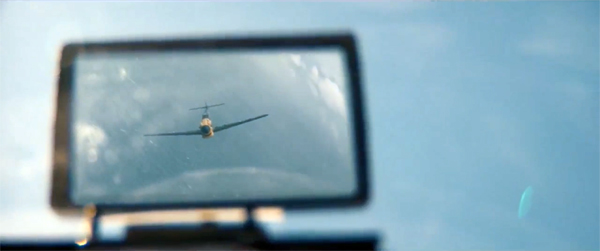
To drive home what it feels like to just barely get by, Nolan ties us tightly to Tommy the foot soldier, Mr. Dawson and his son Peter on their boat, and Farrier the Spitfire pilot, with side visits to Commander Bolton on the Mole. Sometimes he supplies optical POV shots, but more generally he simply confines us to what happens in these men’s ken. The result is both surprise–when the bullets or bombers appear–and suspense, when we cut between Tommy and other soldiers swamped below deck while Gibson struggles to open the hatch and free them.
Even the clicking shut of a cabin latch–or not clicking it shut–generates tension, heightened by the ticking of Zimmer’s score. (At times I thought the pulse in my skull was synched up with the metronomic soundtrack.) The emblem of Nolan’s narrational strategy might be the pitiless shot surmounting today’s entry, showing Tommy flattened while bombs drop one by one behind him, coming inexorably closer to the foreground. Nolan turned superhero films, science-fiction films, and fantasy films into ticking-clock thrillers, and now he does it with a war movie.
The limiting of viewpoint links to some of Nolan’s perennial concern with subjectivity, I think, but it’s also there as a strain within the tradition of war fiction and film. Remarque’s novel All Quiet on the Western Front is like a diary, told in first-person present tense but with flashbacks in the past tense. Catch-22 is in long stretches tied to Yossarian’s jumbled memories of flight missions and hospital stays. Terrence Malick’s adaptation of The Thin Red Line, a film Nolan much admires, turns James Jones’ third-person novel into a lyrical fantasia on war as both a violation of nature and an extension of it, with flashbacks and brooding soliloquys. But in Dunkirk Nolan avoids the deeper registers of subjectivity he’s explored before–no memories, no dreams or fantasies, just brute happenings and the stubborn physical demands of earth and rock and water.
The viewpoint range isn’t as narrow as I’ve suggested, though. Nolan broadens his scope by cutting back and forth among the subjective stretches. Again, this is standard operating procedure in the Big Maneuver film. But that crosscutting was never like this.
Time out from battle
Dunkirk, sans credits, runs a little more than 99 minutes and consists of around 99 sequences. It’s very fragmentary. But then, so is a lot of war fiction. All Quiet consists of many fairly short scenes. Evelyn Scott’s vast novel The Wave (1929) surveys the US Civil War through over a hundred vignettes of the home front and the battlefront, involving characters mostly unaware of each other. William March’s Company K (1933) consists of 113 short segments, each bearing the name of one soldier and told in first-person by him (even if he dies in the course of the episode). Unlike what happens in The Wave, the men are mostly known to one another, and some actions are replayed through different viewpoints. A fancier sort of fragmentation goes on in Mailer’s The Naked and the Dead (1948), which interrupts its scenes with flashbacks (“The Time Machine”) and sections called “Chorus.”
T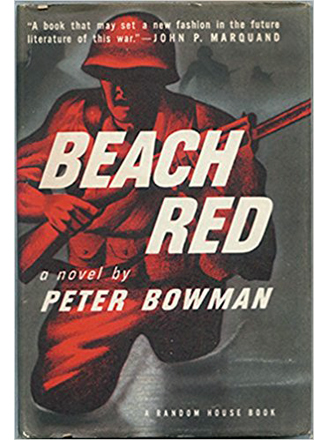 he war novel I’ve seen that’s closest to what Nolan gives us is Peter Bowman’s Beach Red (1946). The story tells of a US effort to capture a Japanese-held island. Bowman wanted, he explained to achieve “a sincere representation of a composite American soldier living from second to second and minute to minute because that is all he can be sure of.” This heightened sensitivity to duration led Bowman to try an unusual strategy.
he war novel I’ve seen that’s closest to what Nolan gives us is Peter Bowman’s Beach Red (1946). The story tells of a US effort to capture a Japanese-held island. Bowman wanted, he explained to achieve “a sincere representation of a composite American soldier living from second to second and minute to minute because that is all he can be sure of.” This heightened sensitivity to duration led Bowman to try an unusual strategy.
His novel is in blank verse, in stanzas of varying length but all conforming to a strict pattern. Each line is equal to one second of story time. Each chapter consists of sixty lines, or one minute of story time. And the book has sixty chapters, representing the hour in which the forces take the beachhead. Like Nolan, Bowman wants a deep, visceral subjectivity, and he aims at this through a frankly mechanical layout of his text. The rigid pattern seeks to force the reader to sink into time. Bowman explains:
I have tried to create a mood of inexorable regularity that would correspond to the subtle tyranny of the military timetable. . . . I have attempted to do for the eye what the ticking of a clock accomplishes for the ear. . . the relentless inflexibility of time itself.
The aching inching forward of time is stressed thematically too, which includes reflections like “Would there be armies if clocks had never been invented?” The book ends with the second-person narration (“You”) dying. Soldier Whitney reports: “There is nothing moving but his watch.”
Like Bowman, Nolan is interested in both the psychology of time and the problem of representing it in his artistic medium. I maintained in our book on Nolan that he isn’t only interested in shuffling chronology. I think that he’s particularly keen on exploring what the technique of crosscutting does to story time.
He has explained that he got the idea from Graham Swift’s 1983 novel Waterland.
It opened my eyes to something I found absolutely shocking at the time. It’s structured with a set of parallel timelines and effortlessly tells a story using history–a contemporary story and various timelines that were close together in time (recent past and less recent past), and it actually cross cuts these timelines with such ease that, by the end, he’s literally sort of leaving sentences unfinished and you’re filling in the gaps.
Crosscutting would become a central artistic strategy for Nolan, a way of shaping his other storytelling choices.
Admittedly, what strikes you first about Memento is its flagrant exercise in reversing story order. But that 3-2-1 sequencing is accompanied by a counterpoint, that of chronologically advancing time, 1-2-3 in the present. Backwards-moving sequences are crosscut with forward-moving ones. Likewise, the structure of Following stems from treating phases of a single action as different story strands which can be crosscut. And the shuffling of order in The Prestige comes from intercutting stretches of two characters’ lives in complicated polyphony.
In his last three films, I think that Nolan, intuitively or deliberately, has hit upon an important feature of conventional crosscutting. Nearly all crosscutting in fictional cinema presumes different time spans, or rather different rates of change, in the crosscut lines of story action. We presume that overall the actions are simultaneous, but at a finer level, they proceed at different speeds. Some parts of the action in one line are skipped over, while other actions in another line are prolonged.
This disparity can be seen in some of Griffith’s classic sequences. In The Birth of a Nation, the black soldiers are inches away from breaking into the cabin’s parlor while the Ku Klux Klan is riding to the cabin, but the riders are miles away. If both strands were on the same clock, the Klan would arrive much too late.
Crosscutting allows Griffth to skip over the distance that the Klan covers, so the riders arrive at the cabin “implausibly” fast. Correspondingly, the glimpses we get of the cabin stretch out the action “unrealistically.” To put it technically, we get ellipsis in one line of action, expansion in the other.
Nolan does the same thing in his crosscut sequences. Consider the passage in The Dark Knight when the judge opens the Joker’s fake message. One or two seconds in her timeline are stretched while Gordon’s conversation with Commissioner Loeb runs on a different clock, consuming several seconds. And when Harvey Dent talks with Rachel and is grabbed by Bruce, that action takes even longer.
To speak of different clocks is a bit misleading; we can’t think that the judge turns over the envelope in super-slo-mo. But the idea of different rates of unfolding is useful because it reminds us that crosscutting aims to convey an overall impression of simultaneity. When we look closer, we realize that the action in one story line can be slowed or accelerated while another story line is onscreen.
Nolan’s interest in this quality of crosscutting is literalized in Inception, in which embedded dream actions unfold at different speeds on different levels. In Interstellar, cosmology motivates crosscutting between slow and fast rates of change. In the first planet the astronauts visit, one hour is equal to seven years on earth, so characters literally live at different rates. The pathos of the film depends upon the fact that Cooper returns, barely aged, to his daughter, to find an old woman on her deathbed. But the differential also allows Cooper to appear to her as the ghost that she saw in childhood and, in circular fashion, set him off on his mission.
The war movie as puzzle film
Nolan notes for Interstellar.
For Dunkirk, Nolan found another way to highlight the rate differences secreted within crosscutting. Like Bowman in Beach Red, he lays down crisp time markers. Farrier’s combat sortie lasts one hour; Dawson’s rescue efforts at sea last one day; and events around the breakwater (the Mole) are said to consume one week. The actual evacuation ran longer, but Tommy and his pal aren’t the last to leave.
These three stretches of action could have been presented as separate blocks. We might have been attached first, say, to Dawson and his boat to attain a pitch of excitement during the bombing of the minesweeper. Then we could flash back to Tommy at the start, in a long lead-up to being rescued by Dawson. Finally we could cover the same events yet again by starting with Farrier’s aerial combats and tracing his fate. The film could have concluded with an epilogue showing Tommy and his pal safely on the train.
Interestingly, Kubrick explored this creative option to a limited extent in The Killing, his 1955 adaptation of Lionel White’s Clean Break. As in the novel, one string of scenes sticks with one participant in a racetrack robbery. Then we jump back in time, guided by a voice-over narrator (“About an hour earlier…”) and follow another man leading up to the situation we’ve already seen. Tarantino did the same block-shifting in Reservoir Dogs, Pulp Fiction and Jackie Brown, and he (rightly) noticed it as a standard literary technique.
Novels go back and forth all the time. You read a story about a guy who’s doing something or in some situation and, all of a sudden, chapter five comes and it takes Henry, one of the guys, and it shows you seven years ago, where he was seven years ago and how he came to be and then like, boom, the next chapter, boom, you’re back in the flow of the action. . . . Flashbacks, as far as I’m concerned, come from a personal perspective. These [in Reservoir Dogs] aren’t, they’re coming from a narrative perspective. They’re going back and forth like chapters.
But Nolan avoided block construction and went for braiding. He splintered his story lines and crosscut them. Events that are mostly taking place at different times are, as it were, laid atop one another and offset. Crosscutting en décalage, we might say.
I’m struck by how bold this is. A more conventional choice would be to confine the action to a fairly brief stretch of time, say two hours, with the rescue fleet arriving at the climax. There might even have been an effort to handle the action as occurring in “real time,” that is, with the duration of the scenes matching their duration in the story. In any event, Nolan could have crosscut his four men–Farrier in the air, Dawson and others at sea, Bolton and Tommy around the Mole–at the points when their activities are roughly simultaneous. If Nolan wanted to include earlier incidents, such as Tommy’s escape from the Germans or his efforts to board the Red Cross ship, those could have been presented as personalized flashbacks. Instead, all that material appears in chronological scenes, but on three distinct time scales.
Nolan set himself enormous problems with this choice. He chose to show the time frames without recourse to an onscreen calendar or clock; after the three initial titles indicating the places and the time spans, we get no more explicit markers. Then Nolan faced the problem of how, on a finer-grained level, to gather these fragments into a whole. He had to create parallels, and, eventually, convergences.
So early in the film, Tommy and Gibson run a stretcher to the departing Red Cross ship.
Cutting makes their urgency flow into that of Mr. Dawson hastening to cast off before the navy requisitions the Moonstone.
Forty-five seconds later Farrier’s team is sent to Dunkirk.
In story time, of course, these aren’t simultaneous at all. Tommy’s attempted escape happens days ahead of Mr. Dawson’s departure, which is hours ahead of Farrier’s mission. But Nolan, aided by Hans Zimmer’s endlessly propulsive score, has given all three primary roles in launching the film’s plot, the start of a time-gapped fugue.
That sort of primacy works at a higher pitch when two life-or-death situations are intercut. Tommy, Alex, and some other soldiers have rashly taken shelter in a fishing trawler, hoping that the tide will carry them away from the beach. But they get pinned inside by target fire. The tide has indeed pulled them out to sea, but the hold is taking on water–at the “same time” (not) that Collins, trapped in the cockpit of his ditched plane, is himself about to drown. The two scenes are intercut.
At the climax, the gestures of rescue are exuberantly crosscut: Dawson hauling on the oily survivors of the blasted minesweeper, the civilians helping the stranded soldiers clamber aboard their boats.
In this passage, Nolan daringly cuts single shots of Dawson’s Moonstone moving as if in sync with the impromptu flotilla, even though he’s some distance off; the crosscutting makes him visually one of the fleet near the Mole.
Crosscutting can also dial up the suspense by delaying the outcome of a line of action. Farrier’s dogfights are pretty much incessant, so cutting away from them to more placid action on the beach or in Dawson’s boat postpones their outcome. Nolan points to another advantage of intercutting the different periods:
You have three different intertwined storylines, and you have them peaking at different moments, so that the idea is that you always feel like you’re about to hit–when you’re hitting the climax of one episode of the story . . . then another one is halfway through and the other one is just beginning. So there’s always a payoff.
Nolan compares this to the “corkscrew” effect of the Shepard Tone in music, which David Julyan used in the drone soundtrack of The Prestige.
At other points, the crosscutting uses one line of action to explain another. While Tommy and Gibson take refuge in the second ship, the Shivering Soldier tells Dawson he refuses to return to Dunkirk because his ship was hit by a torpedo. Soon enough we see a torpedo rip open the ship and plunge Tommy, Gibson, and Alex into the night sea. And soon after that, when they try to clamber into a lifeboat, they’re told by an officer to stay in the water: it’s the Shivering Soldier, pre-PTSD. The contrast between his cool efficiency near the Mole and his spasm of cowardice on the Moonstone is another proof of war’s disastrous impact on warriors.
The lines of action, segregated by crosscutting, intersect eventually. Farrier’s teammate Collins ditches his plane and is rescued by Dawson; later Tommy will get on the Moonstone as well. These are staggered a bit in the film’s unfolding, having the effect of replays. At at least one point, though, I think that all three lines converge. One moment unites Farrier shooting down the German bomber, Dawson steering his ship away from the falling plane, and Tommy, dragged along underwater and hauled to the deck. Shortly the realms of Air and Mole converge when Bolton sees the German plane go down and his men cheer Farrier’s plane as it glides past.
After these moments are briefly pinned together (the script calls it the “confluence”), the time scales diverge again. The epilogue phase of the film resets each strand’s clock. The rescued men arrive at Dorset, and Tommy and Alex board a train at night. Back at the Mole, it’s still daylight and we can see Farrier’s plane burning in the distance. A day or so later in Dorset, the newspaper has published a tribute to George. Now we see Farrier days before, still within his allotted hour of story time, guide the plane down, step out, and set fire to it, as Tommy reads from Churchill’s speech.
Three viewings of the film weren’t enough for me to catch all the alignments, shifts, and echoes, the glimpses of things that take on importance only retrospectively. Early on, a distant shot of Collins’ downed plane briefly shows what turns out to be the Moonstone chugging towards it. On first viewing I was puzzled by Farrier’s view of a sinking private ship; only on the second pass did I realize that it’s the blue trawler that we’ll later see the young soldiers hiding in and fleeing from. And it’s likely, even with many pages of notes, that I’ve mistaken some of the juxtapositions that fly by. (The film averages about 3.3 seconds per shot, and sometimes we jump across story lines in a fusillade of alternations.) Like other puzzle films, the film demands rewatching and scrutiny, and it merits it.
In all, Nolan has taken the conventions of the war picture, its reliance on multiple protagonists, grand maneuvers, and parallel and converging lines of action, and subjected it to the sort of experimentation characteristic of art cinema. (As, in a way, Bowman’s time-grid in Beach Red anticipates the rigor of the Nouveau Roman.) Nolan exploits one feature of crosscutting: that it often runs its strands of action at different rates. He then lets us see how events on different time scales can mirror one another, or harmonize, or split off, or momentarily fuse. As a sort of cinematic tesseract, Dunkirk is an imaginative, engrossing effort to innovate within the bounds of Hollywood’s storytelling tradition.
The juxtapositions aren’t just fancy footwork, I think. In this film, because of the imminence of danger, heroism gets redefined as luck and endurance.
A cynic could call the movie Profiles in Cowardice. Tommy flees German bullets and instead of helping the French hold the barricades, he keeps running. The French boy steals boots and an identity in order to get off the beach sooner. He and Tommy try to slip on board a departing Red Cross ship as stretcher bearers. When that fails, they hide among the pilings. When the ship is hit, they leap into the water, the better to pretend to have been among the survivors and get a new ride. The Shivering Soldier wants to cut and run, and the soldiers who drift beyond the perimeter plan to use the blue trawler to carry them to safety, jumping the evacuation queue. All too often, despite acts of aid and comfort, it’s every man for himself.
At one point Alex claims “Survival’s not fair.” Too right. Mr. Dawson risks his and his son’s life to save a few men, while the lad George, who joined them on impulse and promised to be useful, dies before he can do much, accidentally killed by the Shivering Soldier. The closest the film comes to standard war-movie heroics is Farrier’s cutting down Stukkas. And he doesn’t make it back.
By plunging Tommy and his counterparts into almost unremitting peril, Nolan’s suspense tactics lower the bar for heroism, making us hope that they simply get away, somehow. Trapped on land and sea, you can’t fight dive bombers, U-boats, and marksmen squeezing in from the perimeter. At the end, the boys disembarking at Dorset are reassured that survival was enough. And thanks to Nolan’s crosscutting, individuals at different points in time are shown pulling together to make retreat its own victory.
I wrote nearly all this entry before I got a copy of the published screenplay. Reading Nolan’s conversation with his brother there enabled me to add the quotation about catching lines of action at different points (p. xxii). This conversation also considers the reasons Nolan omitted GHQ scenes (mentioning A Bridge Too Far) and adds comments about Hitchcock, early sound filming (some mistakes here), and The Thin Red Line (“maybe the best film ever made,” xiii). As far as I can tell, the screenplay is fairly close to the finished film until the climactic bombing of the minesweeper; at that point, the onscreen editing doesn’t completely match what’s on the page.
Speaking of climaxes, I should add that even though the film is in Nolan’s sense “all climax,” it also falls quite nicely into Kristin’s four-part structure. I think the midpoint comes when Tommy and his mates head to the blue trawler, starting a typical Development section.
My quotation from Tarantino comes from Jeff Dawson, Quentin Tarantino: The Cinema of Cool (New York: Applause, 1995), 69-70. The Nolan quotation about Waterland comes from Jeff Goldsmith, “The Architect of Dreams,” Creative Screenwriting (July/ August 2010), 18-26 (available, sort of, here).
On the tendency of war novels to play with time, it’s worth mentioning that Catch-22 may exemplify one weird possibility. The Yossarian plotline slips between past and present very fluidly, with some sentences containing several jumps to and fro. The Milo Minderbinder plot is linear, tracing Milo’s building of his empire in 1-2-3 order. But Milo’s progress appears at different moments in past and present in the Yossarian strand, so some critics have argued that the novel has a deliberately impossible time scheme. See Jan Solomon, “The Structure of Joseph Heller’s Catch-22” (1967) and, for rebuttal, Doug Gaukroger, “Time Structure in Catch-22“ (1970). Even if Catch-22 doesn’t actually do this, it remains a creative option that someone should try. Mr. Nolan?
Is the name of Dawson’s boat, the Moonstone, an homage to Wilkie Collins’ 1868 mystery novel? Collins tells the story through different character viewpoints and skips back and forth in time, using replays that gradually explain what’s going on. Mr. Nolan?
For more on block construction, especially in the work of Tarantino, see this entry. You can find more of our thoughts on Nolan’s work in our book Christopher Nolan: A Labyrinth of Linkages (with lots more about crosscutting). See also our blog entries on Inception (here and here), “Superheroes for Sale,” and “Niceties,” and our online article (originally in Film Art) on sound in The Prestige.
Dunkirk (2017).
DUNKIRK Part 1: Straight to the good stuff
Kristin here:
All kinds of spoilers ahead.
The last time I wrote about a Christopher Nolan film on this blog, I was defending the unusual use of protracted exposition to explain Inception’s complicated plot premises. (Critics had complained about the lack of character depth, though I daresay that we knew more about those characters than we do about the ones in Dunkirk.) Concluding that discussion, I said, “I don’t see why we should get annoyed because Inception doesn’t contain rich, fully rounded characters. It’s clearly a puzzle film that takes the usual complicated premises of a heist movie and pushes them to extremes. Accepting the flow of nearly continuous exposition may remove some of the frustrations viewers face. After all, there’s no rule against it.”
Art occasionally does have rules, often imposed from without by government dictate or patronage preference. Artists can impose rules on themselves to guide their creativity, or groups of artists can agree upon rules that define specific types of artworks, like sonnets or sonata-allegro form. But mostly it has norms and conventions–rules of thumb rather than strict rules–and originality consists of playing with them in interesting ways. Now Nolan gives us a film that has even less character psychology and backstory than in Inception, but it also avoids that film’s great lashings of exposition.
Most reviewers seem to have understood that depth of character and explicit elaboration of complex premises are not what Nolan was going for:
If the result holds individual characters at a bit of a remove, then, it isn’t by accident. The enormity of the potential destruction, and the scale of the evacuation and defensive military action, would likely be hampered if the film indulged in too much narrative buildup or character backstory. (Alissa Wilkinson)
In a compact 105 minutes, he takes what was in reality a nine-day effort and brings it all into focus, even without dwelling on a lot of character exposition or development. This is not a typical war picture in which we get much backstory of the men fighting it. […] Told from different perspectives on land, sea, and air, we barely even know the names of the key characters. (Pete Hammond)
The latter point is certainly true. Most of the characters’ names are only given in the credits (and possibly in some of the notoriously inaudible passages of dialogue).
A few reviewers complained, however. Deborah Ross, a critic who in the old days might have been characterized as “dyspeptic,” shunts off her own response onto her readers.
But mostly you must understand that Nolan wants us to come at events as they happened, which means this isn’t about individual heroism, or any kind of character development. (No one carries a letter from a beloved in their inside pocket, for example.) It is brave, and even admirable, but if you are fond of an emotional core? Then you will sorely feel the lack of it. (Deborah Ross)
The readers might or might not find this a failing. Clearly Ross did, but I don’t think this reaction is typical. Surely suspense, empathy, pity, admiration, and ultimately bittersweet relief and pleasure are evoked by this film. My friends and colleagues who have seen the film describe audiences remaining dead silent, a rare thing these days, riveted to the screen throughout. That was certainly true in the two viewings I have had so far.
Let’s assume that Dunkirk does arouse emotions in most viewers, though using an approach that departs from that of conventional war films. Let’s also assume that the story being told is fairly simple, though made elaborate by the ingenious intercutting among the three time frames. David will discuss those two traits in Part 2 of our discussion.
On a need-to-know basis
How Nolan does Nolan convey what little exposition he gives us? Of course, his subject is a famous historical instance of triumph in the face of overwhelming adversity. The Dunkirk evacuation is familiar to most British citizens, and educated Americans and others will have at least a bare-bones notion of the event. Still, he obviously needs to get across points that are salient to this particular film’s treatment of this huge, relatively length operation. (The Dunkirk evacuation took place from May 26 to June 4, 1940.)
Rather than the frequent explanations Nolan used in Inception, here he drops in little pellets of premises at intervals that get broader as the film progresses.
To start with, Nolan gives us the basics of the initial situation–which remains the basic situation until very near the end–all at once with written texts. A title gives the most salient facts about the 300,000 troops trapped by the Germans, and in the first scene the information is supplied with admirable economy by the German fliers dropped on a small band of British soldiers. The one we see in close-up (above) provides the only map we’ll ever see. (At right, the flyer as designed for the film, from James’ Mottram’s The Making of Dunkirk.) Indeed, this is among the few bits of written information we ever get during the main plot; in addition there are the three early titles establishing the geographical areas and their plotlines,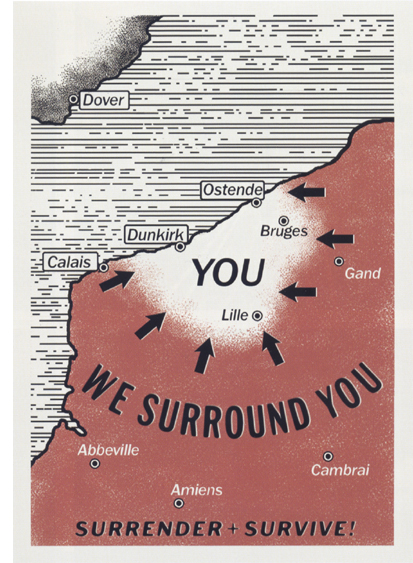 the names of the ships and boats, and the chalked records of fuel levels on the control board of the main pilot, Farrier (Tom Hardy). In a conventional war movie, we might expect explanatory maps pored over by officers or letters from home read out by idle soldiers. Writing returns in the epilogue, with the newspapers that report the triumphant retreat, show us George’s obituary, and provide Churchill’s speech, as read by Tommy.
the names of the ships and boats, and the chalked records of fuel levels on the control board of the main pilot, Farrier (Tom Hardy). In a conventional war movie, we might expect explanatory maps pored over by officers or letters from home read out by idle soldiers. Writing returns in the epilogue, with the newspapers that report the triumphant retreat, show us George’s obituary, and provide Churchill’s speech, as read by Tommy.
Apart from telling us that the troops are surrounded, the white area of the map on the flier explains that the trapped men are on beaches extending from Ostende in Belgium to nearly Calais in France. This lets us know that the entirety of the 300,000 trapped men are not at Dunkirk itself and that we should expect to see only a part of that group. At the bottom of the map and difficult to read (this is why we see it in IMAX) is another message, “Surrender + Survive.” This will be a tale of survival without surrender–apart from Farrier’s heroic self-sacrifice at the end. He surrenders and presumably is killed, while most of the others do survive.
After this we get mere scraps for a significant stretch of time. The notion of an organized, prioritized evacuation is demonstrated rather than explained. There is the soldier at the end of a queue who snarls to Tommy that it’s only for Grenadiers. We see desperate French soldiers turned away from the Mole, where a hospital ship waits to take away the British wounded and those assisting them. We learn all this quickly, barely noticing that we’re receiving exposition, and this plotline can go on for a while with little further information.
The setup of Mr Dawson (Mark Rylance), Peter (Tom Glynn-Carney), and George (Barry Keoghan) is sketchy indeed. We learn that the small private boats are being requisitioned for the rescue effort. Dawson is characterized by his neat three-piece wool suit (he discards the jacket for a sweater) and not much else. The brief scene ends with a shot of stacks of life-preservers waiting to be loaded aboard the Moonstone, perhaps hinting at Dawson’s ambition to rescue a considerable number of men despite the apparent small size of his boat. We do not learn where the Moonstone takes off from, though near the end it’s revealed to be Weymouth, a town quite far west from Dunkirk along the southern coast of England.
A cut to the Spitfires in the sky establishes the third timeline of one hour, and the brief scene mainly serves to allow a voice on the radio to set up the idea of limited fuel, with only 45 minutes at Dunkirk possible: “Save enough to get back!” Another brief scene returns to the beach and we see Tommy (Fionn Whitehead) and his friend Gibson (Aneurin Barnard; the name is given only in the credits, and, not being French, is probably the name on the dog-tags he has stolen) trying to pass themselves off as stretcher-bearers in order to get onto the hospital ship, thus trying to evade the prioritized evacuation system set up earlier.
We return to Dawson loading his boat. He looks anxiously at a group of Royal Navy officers and sailors further along the pier. The officers are assigning small groups of sailors to each of the rescue boats, and Dawson obviously is hurrying to cast off before they can reach his boat. (The three Spitfires pass over the Moonstone at this point, providing the first, tangential link between two of the stories.) Dawson says, “I’m the captain!” further implying that he doesn’t want the sailors aboard his boat. He departs, leaving the puzzled-looking officers and sailors looking after him. We never find out why Dawson is so averse to having a few official crew members abroad, and it isn’t necessary to the plot.
After more crosscutting among the plotlines, a Rear Admiral (Matthew Marsh) shows up to talk with Commander Bolton (Kenneth Branagh) and Colonel Winnant (James D’Arcy). They deliver as big a dose of exposition as we get in the course of the film: the German tanks have stopped, Britain needs to get its army back for future battles, the English coast is a remarkably short distance away, Churchill wants to have at least 30-45,000 men out of the roughly 300,000 trapped on the beach rescued, and the sea at Dunkirk is too shallow for any but small boats.
There is no point in picking out all the moments that provide us with information in the course of the film, especially give that the crosscutting is so insistent that most scenes are split up. Nolan takes advantage, however, of having three threads of action running simultaneously. This allows him to explain something through the action of one thread and have that knowledge carry over into one or both of the others. Most notably, there is the scene where Dawson and Peter rescue the Shivering Sailor (Cillian Murphy) from a nearly sunken ship (top). George asks him, “You want to come below? Much warmer.” the Sailor refuses, terrified, and Dawson tells George, “Leave him be, George. He feels safer on deck. You’d be, too, if you had been bombed.”
Immediately before this scene we had witnessed the hospital ship hit, with men jumping from the deck into the sea. There had been no attention paid to those, if any, below deck. Immediately after the scene of Dawson mentioning feeling safe on deck, however, there begins the extended action of Tommy and his French friend being ferried to another large ship where a nurse sends the men below to get tea and jam sandwiches. The door is locked behind them, and Alex (Harry Styles) asks Tommy where his friend went. Tommy replies, “Looking for a quick way out. In case we go down.”
That ship does go down, with the men and nurses trapped underwater in the locked room until Gibson opens the door and lets at least some, including Tommy, escape. The notion of being trapped below deck becomes a major part of subsequent scenes, as Gibson finally drowns when he cannot make it out of the swamped derelict ship in which a group of the men try to put to sea. At one point the attacks cause such chaos that men in the sea are climbing onto a sinking ship’s top deck while at the same time men on lower decks are jumping into the water.
Partly because of the scrambled time-scheme, some exposition ends up being given remarkably late in the action. Well into the film the second Spitfire pilot, Collins (Jack Lowden), is hit and decides not to bail out but to stay with his plane and ditch it in the water. Shortly after this we return to the point where the three Spitfires had originally flown over Dawson’s boat, witnessed by Dawson, Peter, and George. Dawson identifies them as Spitfires and enthuses over them, saying they have Rolls Royce engines. We have seen several scenes with the Spitfires by the point at which they are identified for us. Not that we absolutely need this information, but it invokes the great affection and admiration felt for the Spitfire in Britain and in general helps motivate Farrier’s feats later in the film. The identification also adds a poignancy to Farrier’s defiant immolation of his plane at the end.
More significantly, near the end of the evacuation portion of the film, Collins asks Peter how his father knew how to sail a boat to evade fire from an airplane. Peter replies, “My brother. He flew Hurricanes. Died third week into the war.” (Hurricanes were the other main type of British fighter plane used during World War II.) Almost any other film would reveal Dawson’s loss of his pilot son soon after he is introduced, to motivate his decision to risk going to save other young man and his zealousness in saving as many as he can. Nolan withholds this until nearly the last time we see Dawson. Even if we didn’t learn this scrap of backstory, we would admire Dawson’s willingness to undertake the rescue mission, and we would accept it as due to the legendary British pluck that underlies the whole story.
If we did learn of the death of Dawson’s son early on, we would be likely to view his actions and statements quite differently through the rest of the film and to focus more sympathy on him. This is not, however, a psychological study in heroism. We do not need to know much about these characters. We are inclined to sympathize with people in trouble, especially ones we know are on the right side in a conflict. The crosscutting, the music, the choice of a small number of point-of-view figures to personalize the actions of a much larger group–all these techniques suffice to keep us absorbed.
Often while helping publicize their films, actors describe elaborate backstories they devised as aids for portraying characters, even though none of the information in those backstories would ever be used in the film. Not so with Dunkirk, at least according to Rylance, who describes the simple assumptions he had about Dawson:
Chris is very particular and very much in control of everything as a director, but he didn’t micromanage any of the scenes. He really much responded to how we played the dialogue he had written. The interesting thing about this film is that it doesn’t have 20 minutes of exposition and back story.
What we do know about Mr. Dawson is that he has a wooden motor boat, which I assume had never been across the Channel before. It was for going out with his family in the Bay of Weymouth, which is a town in southwest coast of England, and maybe going along the beautiful coast. It is a pleasure boat that was built in the 1930s and was therefore relatively new at the time. He has a son, who has a friend who hops on the boat.
There is almost nothing here that we can’t learn from what we see on the screen, and even if one is not familiar with Weymouth, the scenes set there were actually filmed on location to give us a quick impression of the place.
In effect, what Nolan has done is to start his film roughly in the middle of a conventional film story, skipping the Setup (exposition) and Complicating Action portions and starting with what would ordinarily be the Development (obstacles) part of the film and its Climax. Then he provides us with snippets of information to get us up to speed without interfering too much with the suspense.
Finally, we don’t need much information to know why and how such people did what they did, because we know it happened.
The color of suspense
The first short trailer for Dunkirk, called an “Announcement” rather than a “teaser” on Youtube, was posted there nearly a year ago, on August 4, 2016. There were a lot of titles naming Nolan’s previous films, with only six shots, some of which didn’t make it into the final film. The one above, for example, though I’m not sure about some of the others. It’s a pity that one didn’t make the final cut, but my point is that immediately upon seeing that tiny trailer 1) I really wanted to see Dunkirk and 2) I was immediately reminded of James McNeill Whistler’s series of paintings collectively called Nocturnes.
This is rather odd, since the Nocturnes obviously depict night scenes, and relatively little of Dunkirk takes place at night. Whistler’s paintings, however, depict a sort of dusk or night lit up by the glow of London. (They mostly show the Chelsea-Battersea region of the Thames.) They are striking for the wash of nearly monochromatic color with shadowy shapes of buildings or ships or distant shorelines, with a barely distinguishable horizon line, as in “Nocturne: Blue and Silver – Cremone Lights” (1872)
and “Nocturne: The Solent” (1866).
I’m not implying that Nolan or cinematographer Hoyte Van Hoytema was influenced by Whistler. I have no idea whether they’re familiar with the artist’s work. I’m just suggesting that they are using a similar technique. Nolan never tries for the level of abstraction present in Whistler’s Nocturnes, since he has a story to tell, and an epic one, crowded with people and vehicles and incidents. Still, through much of the film he uses an unusually restricted range of colors, mostly shades of brown and tan, gray, blue-gray, and black. There is usually something in the foreground, but the action is placed against backdrops that emphasize this same sort of hazy composition where sea, sky, and land come close to blending. Although the land is termed “The Mole” in the first expository title, the first plot thread introduced is essentially the beach and its surroundings, and so earth, air, and sea are emphasized by the very fact that they are not as sharply differentiated as one might expect in a conventional film.
To be sure, the first scene is crisply focused and brightly lit, so that we can get a good sense of the geography of the beach and sea and the vulnerability of the men crowded on it.
Soon, however, the sunlight disappears, and we are left with a much hazier background of more muted colors, with a gray sky and ocean, as Tommy and Gibson begin their attempt to carry a stretcher aboard the hospital ship.
The Mole itself creates a stark shape, but the ships and smoking buildings in the distance could come straight out of a Whistler canvas.
The effect is enhanced by drifting smoke or, in a another scene, a light fog.
The shots of the planes occasionally show some blue sky or sea, as do a few of the shots of the Moonstone, as in this one with dark blue water forming a sharp horizon.
On the whole, however, the sea shots show a very muted palette, as in the image at the top of this entry.
In contrast, the harbor at Weymouth from which the Moonstone departs creates a much busier composition, with many crisp verticals and highlights of color which, if not bright, are at least cheerier than the hues on the Dunkirk beach.
The point of this restraint in the use of color is clearly in part to capture the realism of the weather. It also, however, enhances the oppression of the men’s situation as they wait for help in a maddening combination of tedium and terror.
The film’s few bits of bright color are mostly red, and they are mostly associated with rescue–successful or not. Early on there are the large scarlet crosses on the rescue ship that is abruptly bombed and sunk.
Later, Tommy and his comrades are served red jam sandwiches aboard another ship that is torpedoed and from which they barely escape.
The successful rescues, however, come from the fleet of small private boats, with their flags providing flashes of color, modest within the huge frame, as befits the little boats they adorn.
These flags are Red Ensigns, with a Union Jack in the upper corner of a red rectangle; they are used by civilian boats in the UK.
Dawson’s ship, oddly enough, flies a Blue Ensign (above) rather than a red one. Is this just an attempt to hold back the red motif until we see the other small boats nearer the Dunkirk coast? Or are we to read a scrap of backstory for Dawson in this particular flag? The Blue Ensign has a confused history, having been used through much of British history for a variety of purposes, and only someone with specialist knowledge would be able to interpret it. Most obviously it might simply identify Dawson as a member of the Royal Dorset Yacht Club, one of a number of such clubs with the right to use that flag. Alternatively, it might mark the Moonstone as being owned by a retired Navy man or a member of the Royal Navy Reserve. In any case, to the degree that anyone notices and interprets Dawson’s Blue Ensign, it motivates his skill as a seaman and his ability to rescue enough men to make an officer back in Weymouth exclaim in astonishment, “How many you got here?” as they disembark.
The use of variants of the Union Jack to create these little flashes of red hardly constitutes a riot of color, but it does effectively mark out the boats (one of which has a set of red sails) and to visually echo the cheers of the waiting soldiers as their saviors approach.
Incidentally, the Spitfires have orange-red dots at the centers of their surprisingly target-like decorations, creating a variant of the motif (below). The penultimate shot in the film lingers on Farrier’s Spitfire, which he destroys to prevent its falling into German hands, blazing away as the red of rescue grows bigger and brighter and comes to signify the defiance we hear as Tommy finishes reading Churchill’s speech–a speech that mentions sea, air, and land.
Whistler’s “Nocturne: Blue and Silver – Cremone Lights” is in the Tate, accession number N03420; “Nocturne: The Solent,” is in the Gilcrease Museum, accession number 0176.1185
You can find more of our thoughts on Nolan’s work in our book Christopher Nolan: A Labyrinth of Linkages, in our blog entry “Niceties,” and in our online article (originally in Film Art) on sound in The Prestige.
Replay it again, Clint: Sully and the simulations
Sully (2016).
What happens in the Forties doesn’t stay in the Forties. That’s one motto of the book I’ve just finished on Hollywood storytelling in the period 1939-1952. The argument is that several narrative conventions that crystallized in that era became part of the Hollywood tradition and continue to shape the films of today.
I say “crystallized,” not “suddenly appeared,” because in general terms every significant technique I pick out has precedents in earlier years of American filmmaking. Forties filmmakers didn’t invent flashbacks, voice-over narration, dream sequences, and the like. What Forties writers and directors did was consolidate those techniques into major norms. They went on to explore, sometimes with startling delicacy, the techniques’ range and power.
This pattern of scattered invention, followed by consolidation and refinement, isn’t uncommon in the history of technology. The computer mouse was devised by several companies and individuals, but it became ubiquitous in the 1980s thanks to Microsoft and Apple. What historians call the diffusion phase of change created a foundation for future development.
The same sort of diffusion sometimes takes place in cinematic form and style. For example, flashbacks in the 1930s were fairly rare and, except for The Power and the Glory (1933) and a few other films, fairly perfunctory. They simply filled in information that had been suppressed earlier, usually providing the solution of a mystery. During the 1940s, when flashbacks became more widely used, filmmakers were obliged by the pressures of competition to explore the technique’s finer-grained possibilities, as in Kitty Foyle (1940), Citizen Kane (1941), Lydia (1941), and many other films.
Once a technique becomes common, and refined in its usage, later filmmakers can treat it as a taken-for-granted option. It seems likely that the development of flashbacks in the 1940s, in both American and other cinemas, laid the groundwork for efforts like Hiroshima mon amour (1959). American filmmakers reworked flashbacks in creative ways in Petulia (1968), They Shoot Horses, Don’t They? (1969), and other films influenced not only by 1940s Hollywood but also by 1950s and 1960s European cinema.
Call me biased, but now nearly every mainstream movie I see seems indebted to storytelling strategies consolidated in the 1940s. Take Sully. In less than ninety minutes, it runs through a wide range of narrative techniques. The fact that we take them so completely for granted, and understand them so swiftly, indicates the stability of what we call a Hollywood movie. It’s kind of miraculous that filmmakers continue to find ingenious ways to fulfill norms that were locked into place seventy years ago.
Clint the classicist
American Sniper (2014).
Before I get to Sully, let’s pause on other recent films directed by Clint Eastwood. (Yes, spoilers will be involved.) They illustrate just how fully narrative techniques associated with the 1990s-2000s have become mainstream resources. Although those techniques are largely revisions of possibilities crystallized in the 1940s, most people know them in their modern guise. Today’s audiences are more familiar with the intricately out-of-order flashbacks of The Prestige (2006) than those found in The Killers (1946) or Backfire (1950).
Hereafter (2010), written by Peter Morgan, lays out three story lines. A French TV journalist, after nearly drowning during a tsunami, is convinced she has had a vision of the afterlife. A London boy yearns to contact his dead twin. An American construction worker, as a result of perilous childhood surgery, has acquired the gift—or, as he says, the curse—of being able to communicate with the dead. Each protagonist’s experiences are treated as separate blocks, crosscut ever more swiftly, until the three converge at a London book fair. The American helps the boy contact his brother, and by meeting the journalist, who has written a book about her research into the hereafter, begins to feel he can rejoin the world.
Hereafter is what I’ve called a network narrative: a plot centered on several more or less equally weighted characters with independent goals. Their fates intertwine by chance (or fate). In the 1930s and 1940s, network plotting tended to be confined to a locale or vehicle, typically in a Grand Hotel situation. More dispersed and numerous story lines emerged with Altman’s Nashville (1975), though even that has a circumscribed time limit. During the 1990s and 2000s, both spatially confined versions and more free-ranging ones became quite common in filmmaking across the world. Hereafter revives the strategy, tying the parallel plotlines to a conception of a realm after death.
Hereafter’s second primary expressive option involves flash-cut visions of the afterlife—blurry, distorted images that give only a glimpse of what Marie the journalist and George the medium “see.” These aren’t sustained, so that, for instance, when George relays to someone what the departed is saying, the film stays objective, simply presenting George’s report on what he’s being told.
This reticence about showing us the Beyond allows us to reflect that at one crucial moment, perhaps George is improvising the advice that he claims to be passing along to the dead boy’s twin.
In a final twist, George’s curse changes to something more like a gift. When he manages to arrange a rendezvous with Marie, his vision of the afterlife is replaced by precognition in this world. Now his vision, clear and sustained, shows him kissing her. Or maybe he’s gained access to normal wish fulfillment.
In either case, the Hollywood clinch gets re-motivated.
Jersey Boys (2014) presents the rise of the Four Seasons, with emphasis on the lead singer, high-pitched and high-strung Frankie Valli. Although the bulk of the film takes place in the 1950s and 1960s, it climaxes with the group’s reunion at the Rock and Roll Hall of Fame in 1990.
A common option would be to start at the reunion and then flash back to trace the group’s rise. Instead, the film roughly follows the layout of Marshall Brickman’s and Rick Elice’s book for the Broadway show. That presents the ups and downs of the group’s career chronologically, with each member narrating a block of scenes. In the stage version each block is labeled, cutely enough, with a season, from ebullient spring to doleful winter, with an extra-seasonal epilogue at the Hall of Fame.
The film version, also scripted by Brickman and Elice, doesn’t flag the seasons but does incorporate round-robin narrators. In the film’s opening Tony DeVito introduces us to the neighborhood and the formation of the group.
Later, singer-composer Bob Gaudio (above) and bass guitarist Nick Massi comment on stretches of the group’s rise and fall. They feel free to criticize each other, as when Nick says the trouble began well before Bob thought. These narrating moments are handled through to-camera address: each Season looks straight at us, explaining what’s happening, or just happened, or is about to happen.
Again, to-camera address can be found throughout film history, but the Forties made it salient by letting it bracket the entire film, often as the present-time frame for a flashback (Mr. Blandings Builds His Dream House, 1948; Edward, My Son, 1949; Young Man with a Horn, 1950; below). It’s rarer to have the narrator interrupt an ongoing scene, turn toward us, and break the fourth wall, but we do find it in My Life with Caroline (1941, below).
The Caroline device was revived in other films, notably Alfie (1966) and much more recently The Wolf of Wall Street (2013). The tweak that Jersey Boys introduces is the fact that the narrator uses the past tense to describe the scene he’s in–an occasional option in The Big Short (2015) too.
The tag-team narration in Jersey Boys doesn’t create sharply distinct blocks, in the Rashomon manner. Each singer’s segment roams pretty freely among other characters’ doings, so there’s no strong attachment to a single viewpoint. But some variations crop up. Frankie is the most minimal narrator. He never turns to the camera to address us, and we hear his voice-over comments only once in “his” stretch of the film. Perhaps that’s because he’s the character whose personal life is most crucial to the plot, and we see everything he’s up to. (Hollywood group protagonists often adopt a “first among equals” principle.) And at the final reunion, each of the quartet turns from the microphone to address us in quick succession, summing up their view of what’s happened. In Jersey Boys, as in Hereafter, some long-standing conventions are given moderately original handling.
American Sniper (2014) is the most linear and traditional of this batch, except for one tactic that becomes more important in Sully. The opening sequence shows sniper Chris Kyle perched atop a building scanning the Falluja neighborhood for enemy action. He sees a woman and child walking toward the Marine convoy, and she passes the boy what becomes visible as a grenade.
Chris must decide whether to fire. We then flash back to Chris as a boy shooting a deer and being told by his dad: “You got a gift.” There follow scenes tracing his childhood and young manhood, and his response to militant bombings of U. S. embassies: joining the Navy SEALS. At his wedding, he’s called to the invasion of Iraq.
This flashback, which consumes most of the film’s first “act” (ending about 25 minutes in), is followed by a return to the moment of decision on the rooftop. To prolong the suspense, the film replays Chris’s spotting of the woman and child with the grenade. He fires and kills both.
This tactic, of coming out of a flashback with a repetition of what initiated it, is yet another storytelling choice we find emerging in the Forties. One clear example is the framing of the long central flashback of Body and Soul (1947). The opening scene shows an eerily empty training camp before boxer Charley Davis wakes up from a bad dream and cries, “Ben!”
A fairly lengthy setup in the present follows before we get a long flashback tracing Charley’s career. At the conclusion of the flashback, again we see the shot of the camp, and again we see Charley awakening. A match-on-action cut takes us from that to the point where the frame story stopped: him lying on the table in his dressing room, just before the big bout.
The return to the camp has buckled the flashback shut in a way similar to the return to the Falluja roof in American Sniper.
The device of the reiterated flashback is developed more unusually in Eastwood’s J. Edgar (2011). The film follows a classic norm for the biopic: In old age, the central character recalls his or her life. Those flashbacks could be motivated as private memory, or as episodes recounted to someone. And in the Forties, that someone was often a reporter or transcriber, as in Edison the Man (1940) and The Great Man’s Lady (1942). If you count Citizen Kane (1941) as a fictional biography, then Thompson fulfills the role of listener.
In J. Edgar, the self-important Hoover has assigned FBI agents to take down his memoirs. Flashbacks inevitably follow. As the film goes on, the narration wedges in “unofficial” flashbacks, mostly scenes with Hoover’s life partner Clyde Tolson, and these are justified as purely private musings.
What’s interesting is that some material Hoover dictates proves unreliable. At the climax Tolson, who has read the manuscript, denounces it as a tissue of lies. We then get repetitions of key scenes from the dictation, all of which show that Hoover wasn’t involved in cracking the big cases he took credit for. The film decisively debunks Hoover’s myth that he was not only a superb administrator but also a heroic, hands-on field commander.
The lying flashback is yet one more minor convention of 1940s cinema. For those who haven’t seen the most important example, I’ll refrain from mentioning the title, but let Thru Different Eyes (1942) and Crossfire (1947) stand as examples. (At one phase of production, Laura, 1944, was planned to have a lying flashback too.) The replay emerges as a way to correct the first impressions.
In tracing precedents for these storytelling choices, I don’t mean to criticize them as unoriginal. The screenwriters of Jersey Boys and Hereafter, along with Jason Hall (American Sniper) and Dustin Lance Black (J. Edgar), are drawing upon models that have been circulating in Hollywood filmmaking for decades, and that became particularly salient in the 1990s and 2000s. These scripts are also revising the techniques in ways that seem to me original to some degree.
As for Eastwood, he’s said to “shoot the script,” so perhaps these more or less up-to-date narrative techniques are brought into his work through the screenwriters. But he’s also often called one of the last “classical” directors. Partly, I think, that’s a reference to his style: his fondness for establishing shots of buildings, shots of people arriving in cars or driving away, shot/reverse-shot dialogue exchanges, and unobtrusive Steadicam. In Jersey Boys, the musical numbers seem rather haphazardly put together, but Eastwood is cogent in developing action sequences, as the firefights in American Sniper show.
It’s not just a matter of style, though. To some extent the narrative strategies I’ve mentioned here have become part of today’s “classical Hollywood filmmaking.” Flashbacks, block construction, replays, to-camera address, network narratives, and bursts of subjectivity are so ingrained in contemporary filmmaking that we might want to think of Hollywood storytelling as a constantly expanding menu that discovers new flavors in traditional ingredients. The basic premises of classical narrative permit an indefinitely large range of variation, both large-scale and fine-grained.
Not a crash, a water landing
Most flashbacks present new information, either in a large block, as in Body and Soul, or in bits, as in J. Edgar. Other flashbacks present old information, mostly to remind us of something we’ve already seen or heard that’s relevant to the moment. Occasionally, a flashback is both a reminder, because it shows us something we’ve seen before, and a source of new information. It’s very common for mystery films and TV shows to use a flashback to an earlier scene in order to fill in whodunit, and how it was done.
Let’s call this reminder involving new information a replay. A replay goes beyond a simple repetition by showing the action in a new light—from a different character’s perspective, or including information that was omitted on the first pass. The latter happens in J. Edgar, when we see earlier scenes corrected to give credit to the actual agents involved.
Replays and other techniques of repetition are given a remarkably central role in Todd Komarnicki’s screenplay for Sully. It’s not surprising because the core incident, Chesley Sullenberger’s landing of a damaged airliner on the Hudson River, is said to have consumed only 208 seconds. There would have been many ways to tell this story; a straight linear account, as in United 93 (2006), must have been a tempting option. Instead, Sully concentrates on the heroic pilot, whose action was supported by comradeship with his co-pilot, and the collective spirit of the passengers, crew, and first responders. In order to add conflict, Komarnicki and Eastwood build up the drama of the National Transportation Safety Board’s inquiry into the landing. The members of the board are initially presented as skeptical antagonists, although by the end, they gracefully acknowledge that the plane could not have returned to the nearest airfields.
The emergency landing is presented in flashbacks, framed by the ongoing investigation. But the film opens with the plane crashing into Manhattan skyscrapers.
It’s revealed as Sully’s nightmare, which haunts him after the rescue. The sequence anchors us firmly in his consciousness; we’ll be more attached to him than to any other character. As an anxiety dream, it presents a sort of what-if version that retrospectively justifies his decision to land on the Hudson. But its emotional tenor reveals his consistent worry throughout the plot that the authorities will judge that he put the passengers’ lives at risk unnecessarily.
Later another version of this Manhattan crash plays out not as a dream but as a waking fantasy, as Sully looks out of a skyscraper window. The scene suggests that he’ll never be able to see this cityscape without imagining the catastrophic alternative scenario. The same fraught feelings crop up in another fantasy passage, when he imagines a TV commentator asking: “Sully: Hero or fraud?” It isn’t just the accusation from outsiders that worries him. He questions what he’s done too. It’s important that the film give Sully enough self-doubt to build our sympathy and to make his final vindication all the more deserved.
Having given us dream and daydream, the filmic narration also gives us memory, in the form of flashbacks to Sully’s younger days, when he fell in love with flying and graduated to testing aircraft in dangerous situations. These affirm his expertise while also showing the quiet determination that can seem a little dour. (He’s told by his flight instructor to smile more.) This serious older man was also a serious young one.
From the start, the Board’s inquiry sets up the need for simulations to check Sully’s decisions. The first set are computer-based, and Sully requests that pilots also execute simulations. The human simulations will become crucial points of conflict at the climax.
One of Sully’s phone calls to his wife back home triggers the first flashback to the fateful day of 15 January 2009. This is launched about 27 minutes in, marking the shift to what Kristin calls the Complicating Action section of the plot. We’re shown Sullly’s arrival at the airport, the assembling of the passengers, and the takeoff. Soon enough, a flight of birds hits and the plane is damaged. Sully and copilot Jeff Skiles radio the air control center.
At this point, our attachment shifts to the controllers, and we hear the pilots trying alternative options. Other aircraft in the area see the plane go down, and the controller is relieved to learn that the landing was successful.
Crucially, we aren’t in the cockpit throughout this first run-through of the landing. Although the film celebrates Sully, the narration initially shifts our attachment to others trying to help him. This tactic also allows the filmmakers to save the most dramatic version of the landing for later replay.
The second major flashback, triggered by Sully brooding in a pub, shows the rescue operation. There’s a replay of the plane’s descent, again refracted through observers. Some are eyewitnesses, but mostly we see coast guard people who leap into recovery mode.
We alternate those views with vignettes of the passengers evacuating, overseen by Sully’s apprehensive effort to make sure all survive. Even after the passengers have been taken aboard the rescue boats, Sully can’t calm down until he’s told that the tally shows that everyone is safe.
The end of the flashback, which I’d say constitutes the Development section in Kristin’s model, introduces the crucial motif of timing, which will be Sully’s defense at the last hearing.
We’ve registered the water landing from the perspectives of the air-traffic controller, of eyewitnesses on the ground, of the first responders, and of the passengers. But what were the 208 seconds like inside the cockpit? This will be the business of the film’s climax, and several versions of it will be presented.
At the final hearing of the NTSB, a public one, the Board members report on the computer simulations. Those indicate that the plane could have flown back to La Guardia or on to Teterboro for a safe landing. Then the Board, through video contact, shows pilots simulating the alternatives, instant by instant starting from the bird strike. These reenactments are a bit like Sully’s nightmare and daytime fantasy, in that they present grim alternative scenarios—hypothetical replays, we might say. Both confirm the computer’s conclusion that the water landing wasn’t necessary.
A fair amount of suspense has been built up by these reenactments. The audience hasn’t seen everything that happened in the cockpit during the crisis. How can these simulations be challenged?
Sully raises the crucial point that the pilots in the simulation had foreknowledge of what they were to do. (In cognitive-science jargon, they were primed.) In fact, the Board admits, the pilots were permitted to practice the maneuver several times. Sully requests that time be added to the simulation, as a way to reflect the real conditions of unexpected decision-making.
So the pilots run the simulations again with a 35-second lag. Both the La Guardia and Teterboro options now lead to crashes. Sully and Skiles are vindicated. Finally, we get a full-blown replay of the critical action in the cockpit, thanks to the Board’s playing of the flight-box recorder. We hear the pilots’ conversation while the film flashes back to show Sully and Skiles facing the crisis.
Thanks to editing, the 208 seconds from “Birds!” to safe landing gets expanded a little in this replay. (By my count, it runs about 330 seconds.) And we aren’t wholly confined to the cockpit visually, as we can trace the plane’s progress from outside. Basically, though, we’re attached to the two men, sometimes through optical POV shots. Although we saw the early phase of the pilots’ routine safety responses in the first long flashback, now we see the whole process, culminating in Sully’s decision to land on the Hudson.
What might have been a strenuous exercise in padding, replaying the crucial moment just to stretch the action out, becomes a strategic way to balance individual and collective effort. The first two long flashbacks stress the roles of the air-traffic controller, the crew, the passengers, and the first responders. In this respect the heroism is spread out, showing a collective effort to save the situation. Only at the climax does the film confirm what many witnesses have said from the start—that Sully deserves to be called a hero. The NTSB officials pay tribute to him as the x-factor, the crucial figure in the equation. But he demurs: “It was all of us.” The theme of group accomplishment is made tangible by the film’s play with plot structure and narration.
The replay flashback wasn’t unknown in silent film, and sound examples include The Canary Murder Case (1929) and The Witness Chair (1936). Nevertheless the replay becomes quite elaborate in the 1940s, with Mildred Pierce (1945) being a particularly intricate example. It’s clearly an idea circulating through the filmmaking community: Cukor wanted a replay for A Woman’s Face (1941) and Mankiewicz wanted one for All About Eve (1950). (He got one in the self-produced Barefoot Contessa, 1954.) An almost fussy example can be found in the British flashback film, The Woman in Question (1950). Since then, the replay has been a rich secondary resource for Hollywood. Its widespread revival, and repurposing, in modern cinema reminds me of a remark made by André Bazin.
Sometimes Bazin’s reference to “the genius of the system” is taken as praise for the Hollywood studio system as an economic enterprise. I don’t read it that way. I think he was referring to the fecundity of a particular storytelling tradition.
The American cinema is a classical art, but why not then admire in it what is most admirable, i.e. not only the talent of this or that filmmaker, but the genius of the system, the richness of its ever-vigorous tradition, and its fertility when it comes into contact with new elements.
Bazin gives as examples of such “new elements” the commentary on American society to be found in films like Bus Stop and The Seven Year Itch. In such films, “the social truth . . . is not offered as a goal that suffices in itself but is integrated into a style of cinematic narration.” Sully does much the same thing. Seizing on the bare incident of Captain Sullenberger’s landing and its reception by the public, the filmmakers have integrated it into a narrative pattern that is at once traditional and novel.
It’s this interplay of narrative convention and innovation I try to trace across a single period in Reinventing Hollywood: How 1940s Filmmakers Changed Movie Storytelling.
The citation of Bazin comes from “On the politique des auteurs,” in Cahiers du cinéma: The 1950s: Neo-Realism, Hollywood, New Wave, ed. Jim Hillier (Harvard University Press, 1985), 258.
I discuss network narratives in The Way Hollywood Tells It, pp. 9-103, and more extensively, drawing examples from world cinema, in “Mutual Friends and Chronologies of Chance,” in Poetics of Cinema, pp. 189-250. On this site, see this entry on Grand Hotel (1932), this one on Life without Principle (2011), this one on some examples from the 2000s, and another about Babel (2006). One from last winter compares network narratives to films with one or two protagonists. See also Peter Parshall’s book Altman and After (Scarecrow, 2012). Want to see a combination of network narrative and maniacal replays? That would be Vantage Point (2008), which I once intended to write about here before a trip to Asia deflected me. . . .
To-camera address in The Wolf of Wall Street is considered here. In another entry I discuss traces of the would-be replay in All About Eve. “Play It Again, Joan” considers purely auditory replays. To compare a replay with a film’s first iteration, you can check my analysis of Mildred Pierce and the video therein. I discuss a pseudo-replay in The Chase (1946); it’s weird, but that’s the Forties for you.
Other examples of modern assimilations of 1940s techniques are discussed in this entry on fragmentary flashbacks and this entry on Tarantino. And of course there’s the labyrinth of linkages we find in The Prestige. For other relevant entries, check the category 1940s Hollywood.
Jersey Boys.












